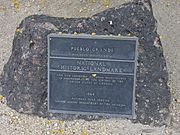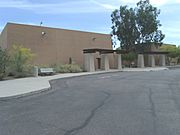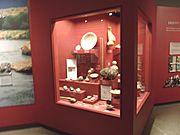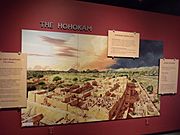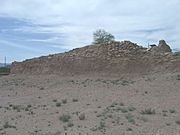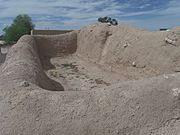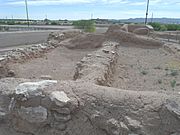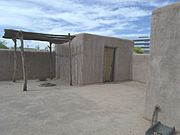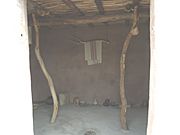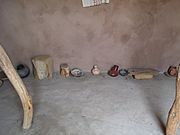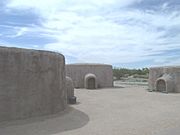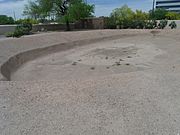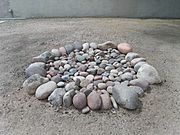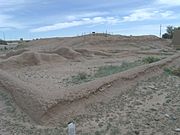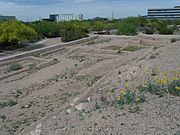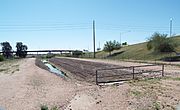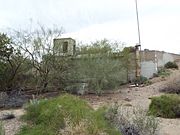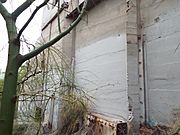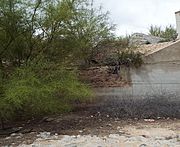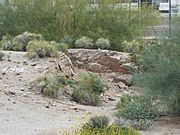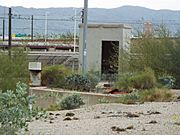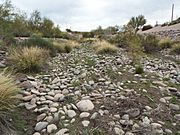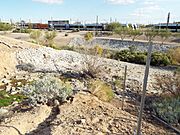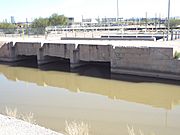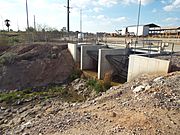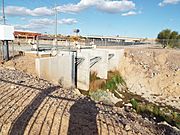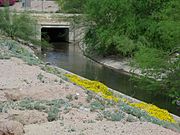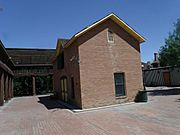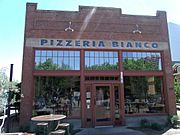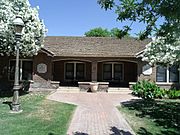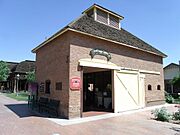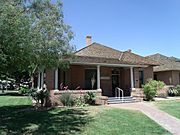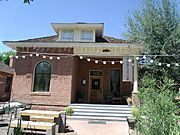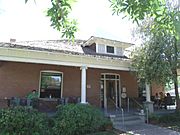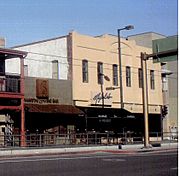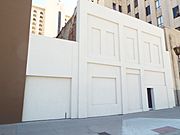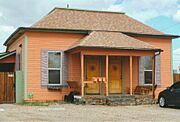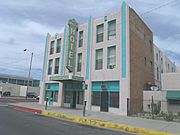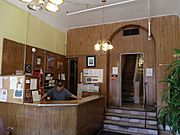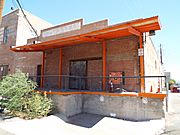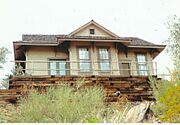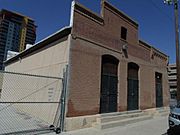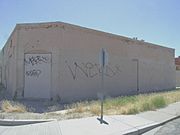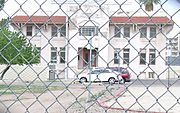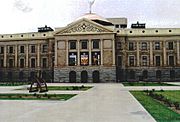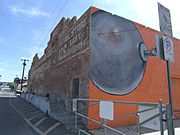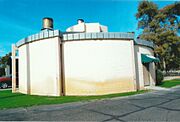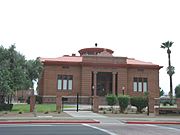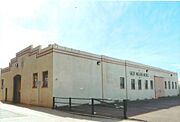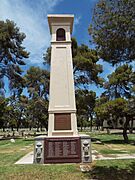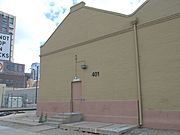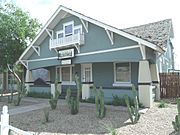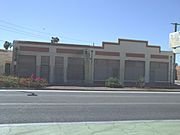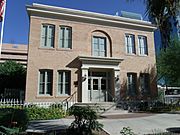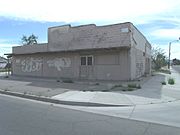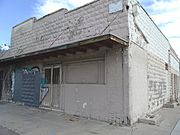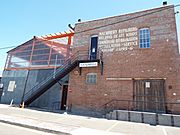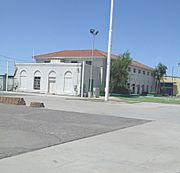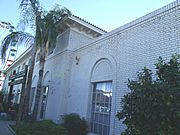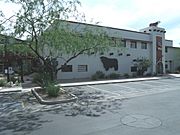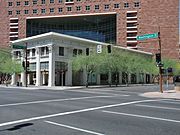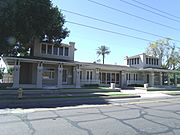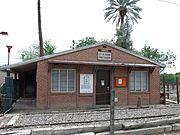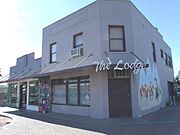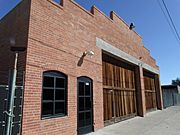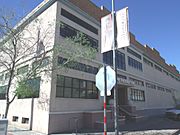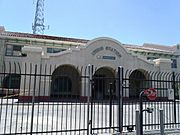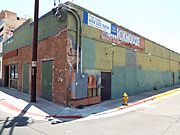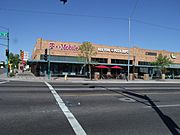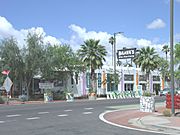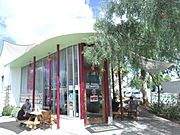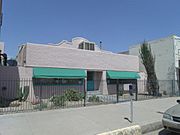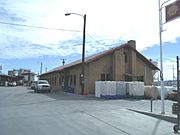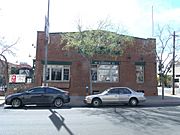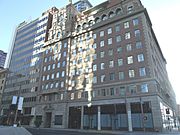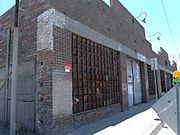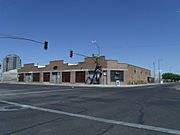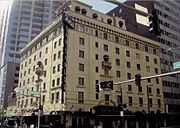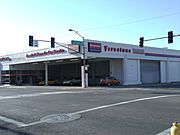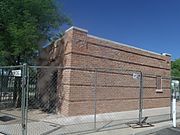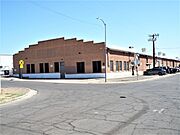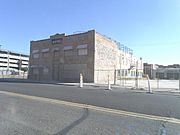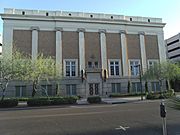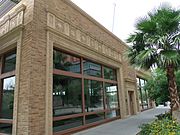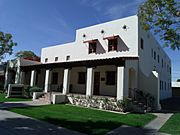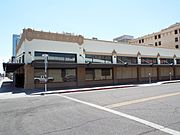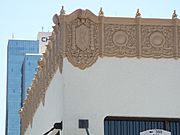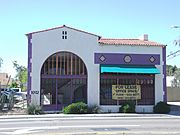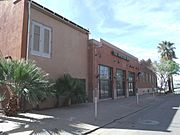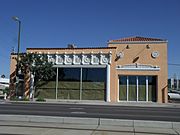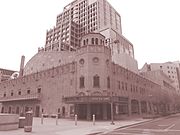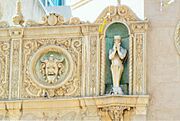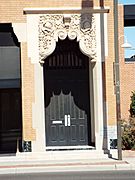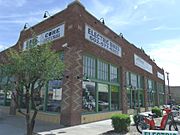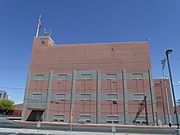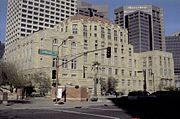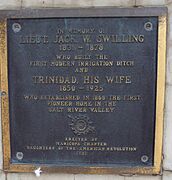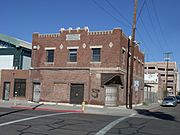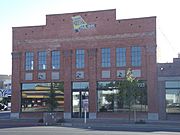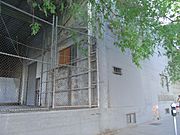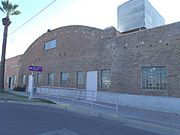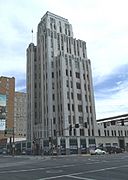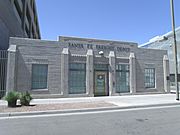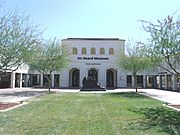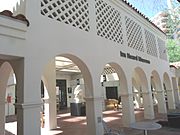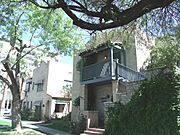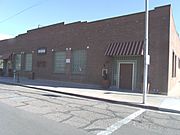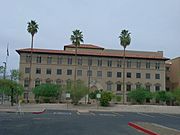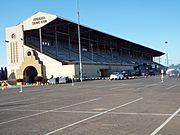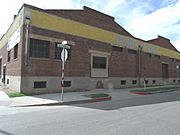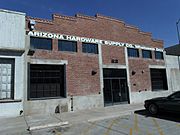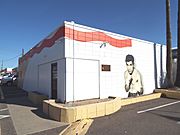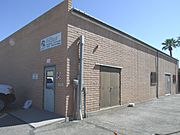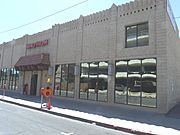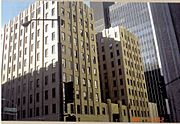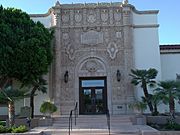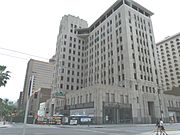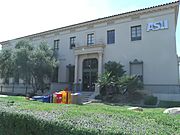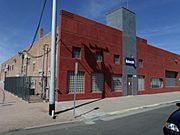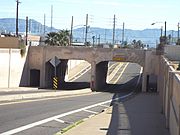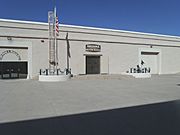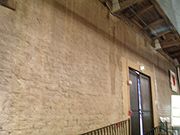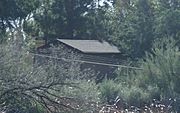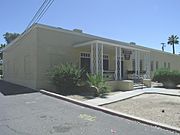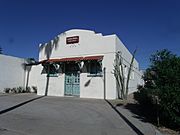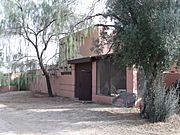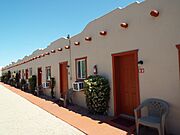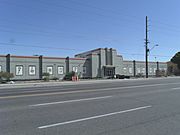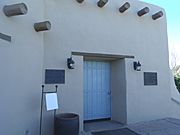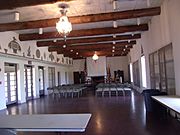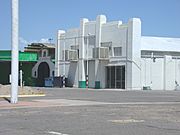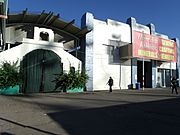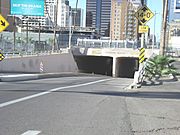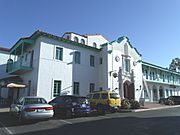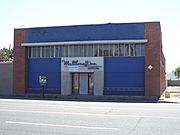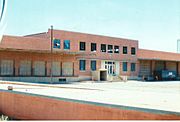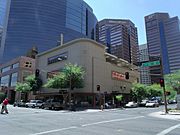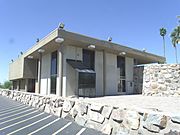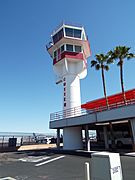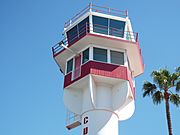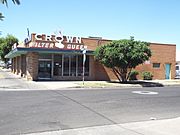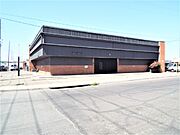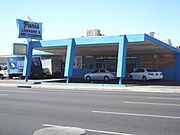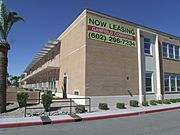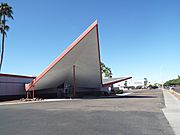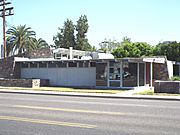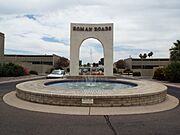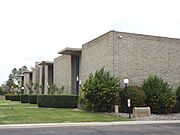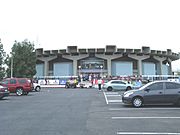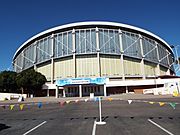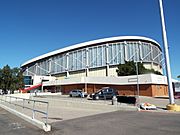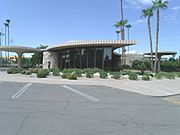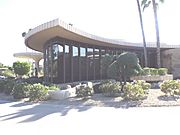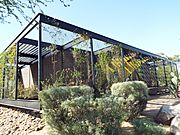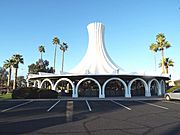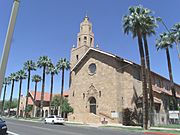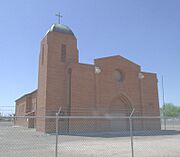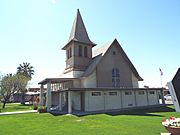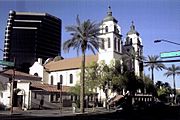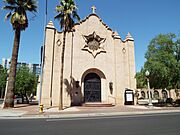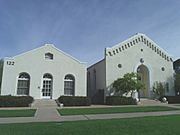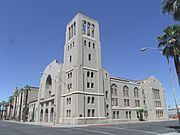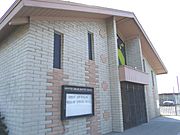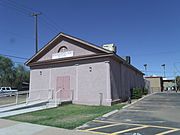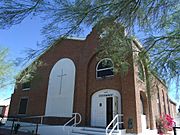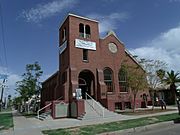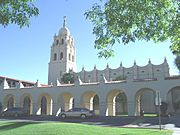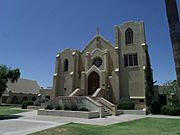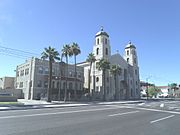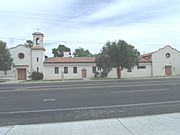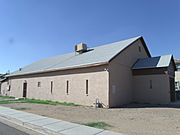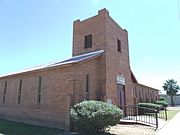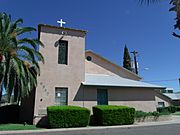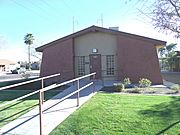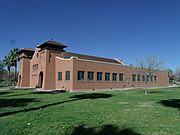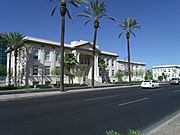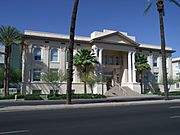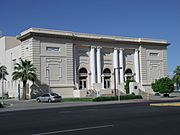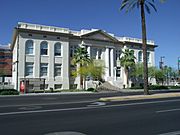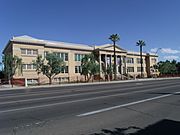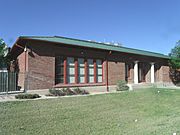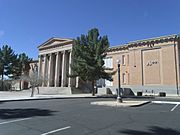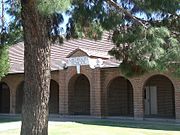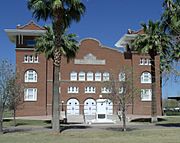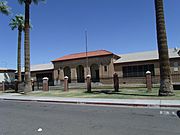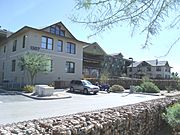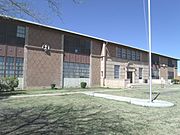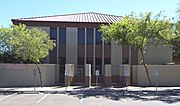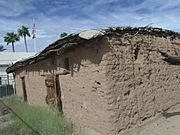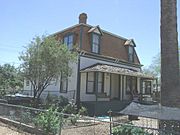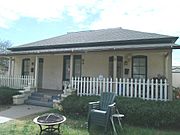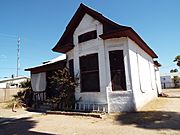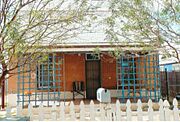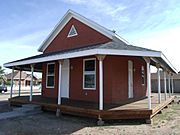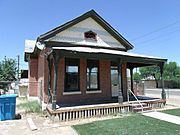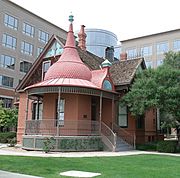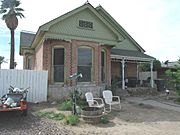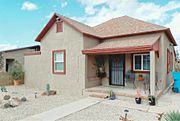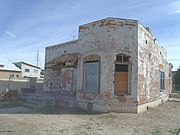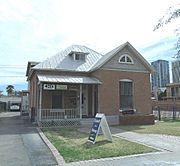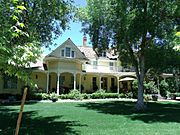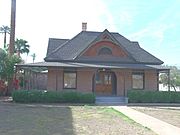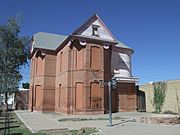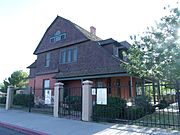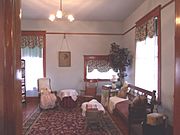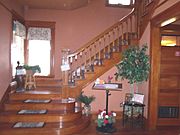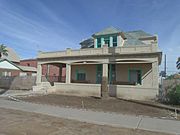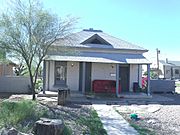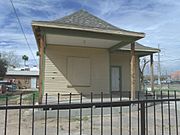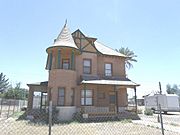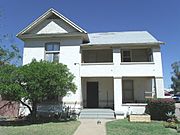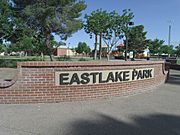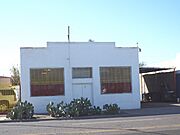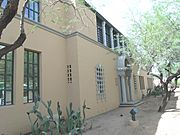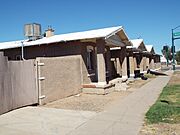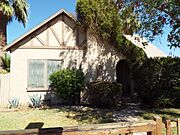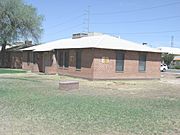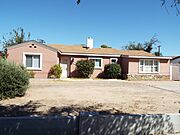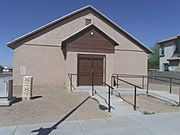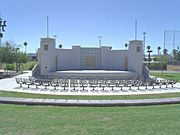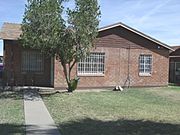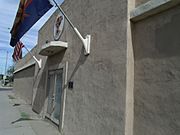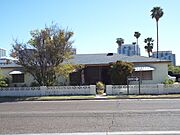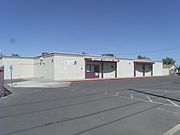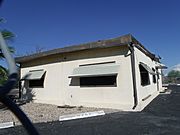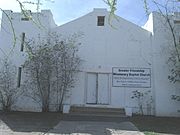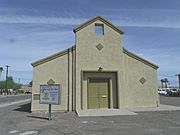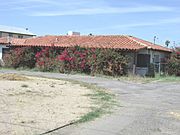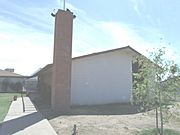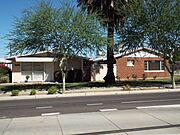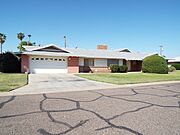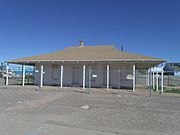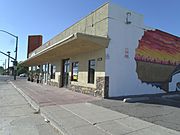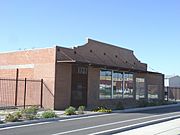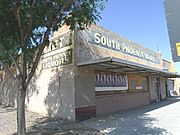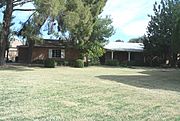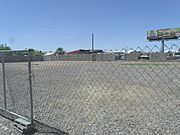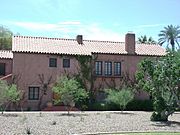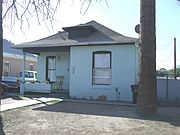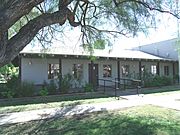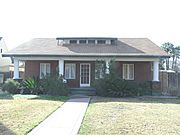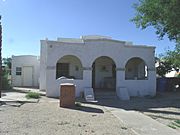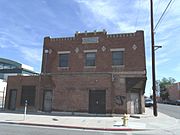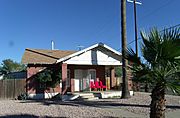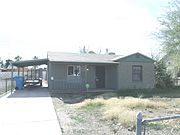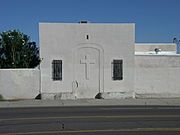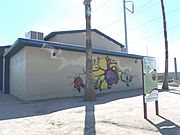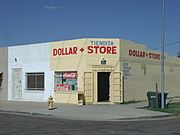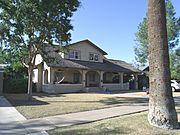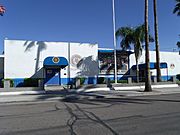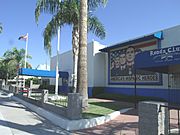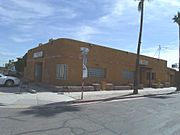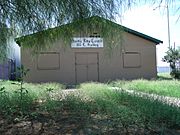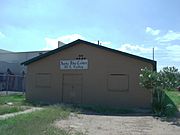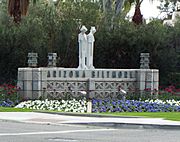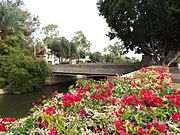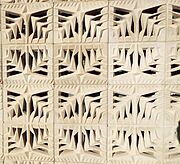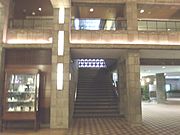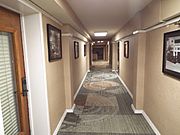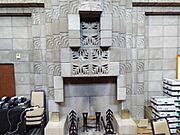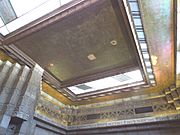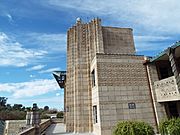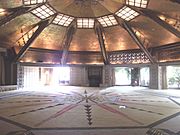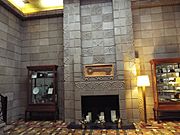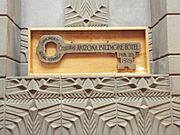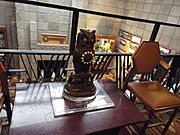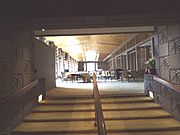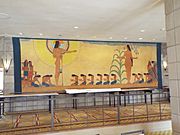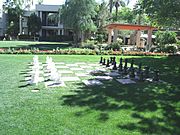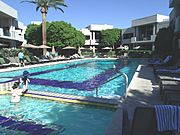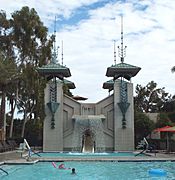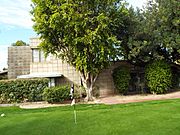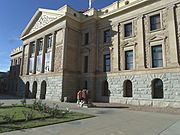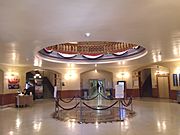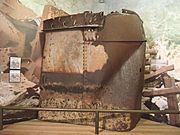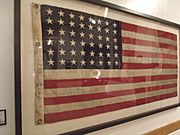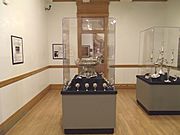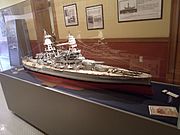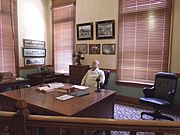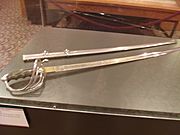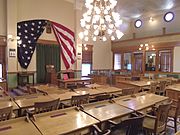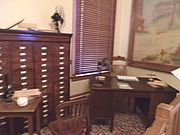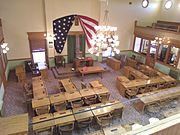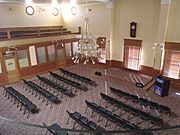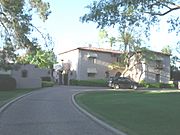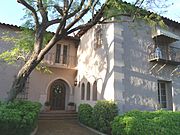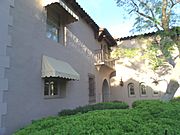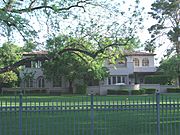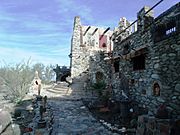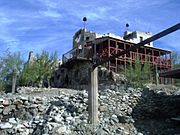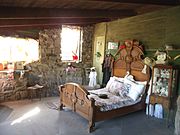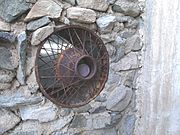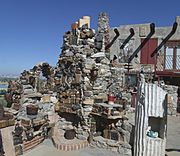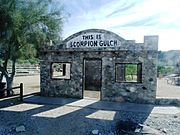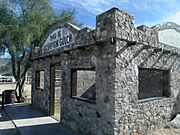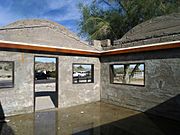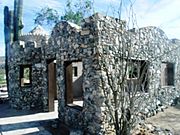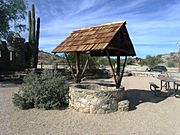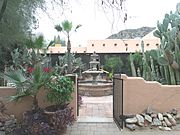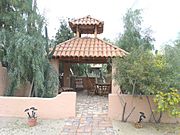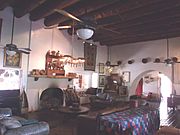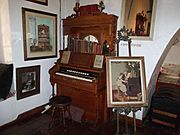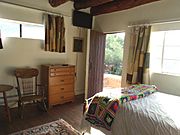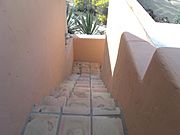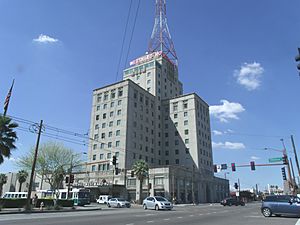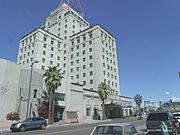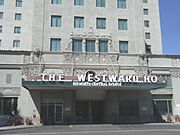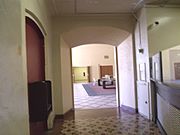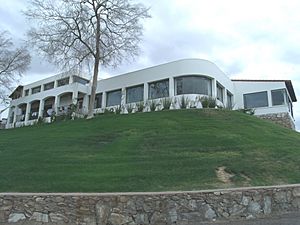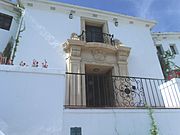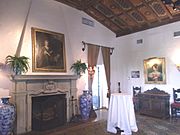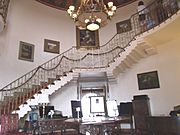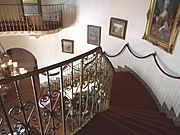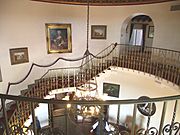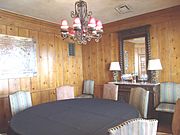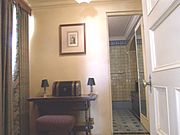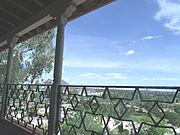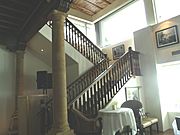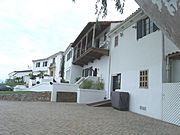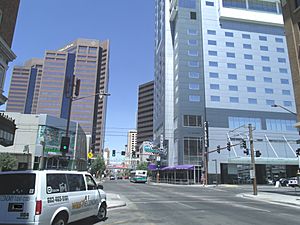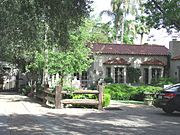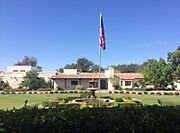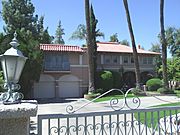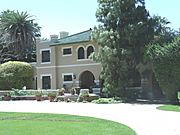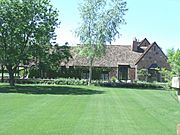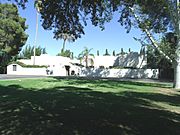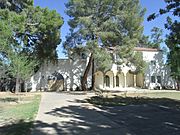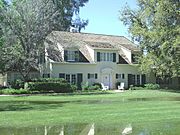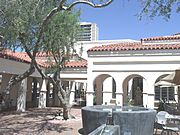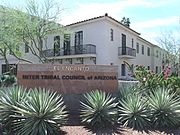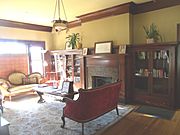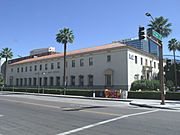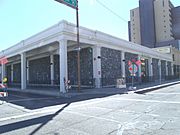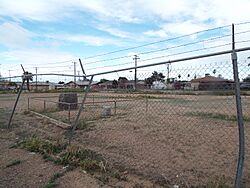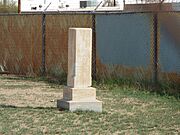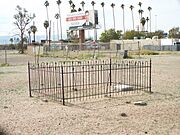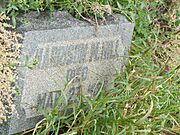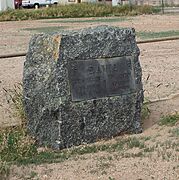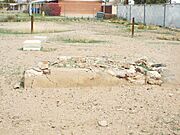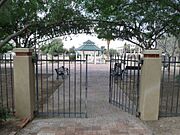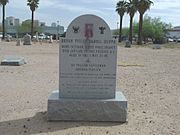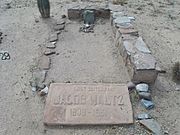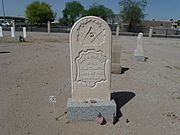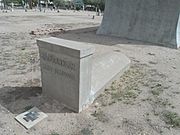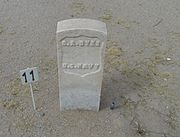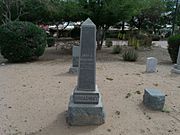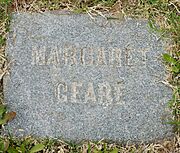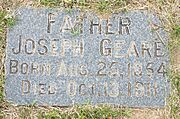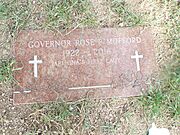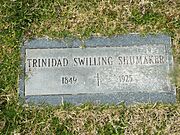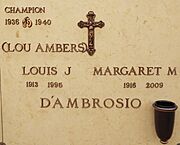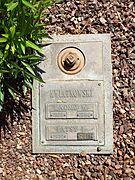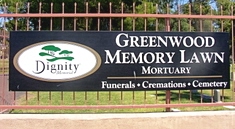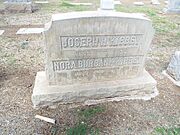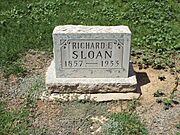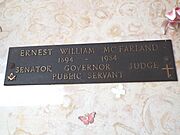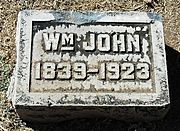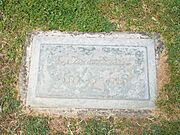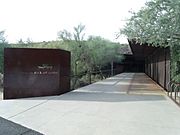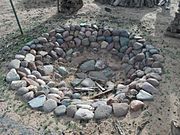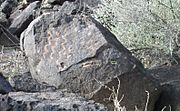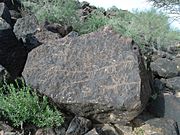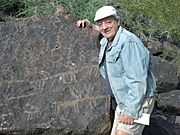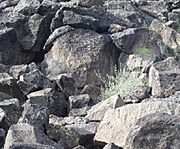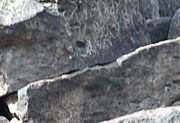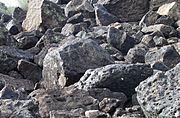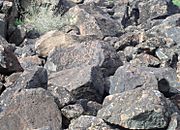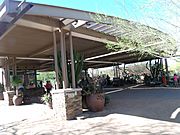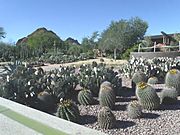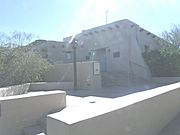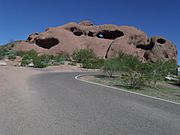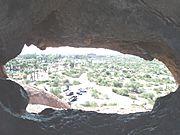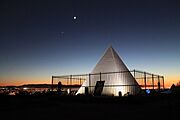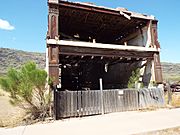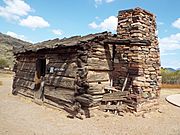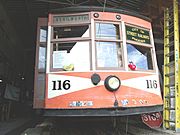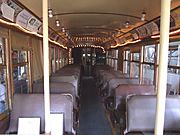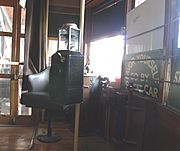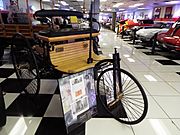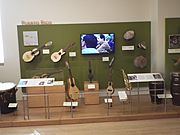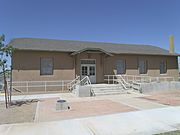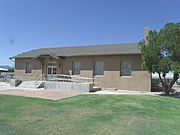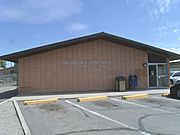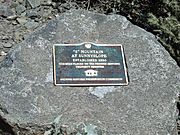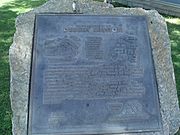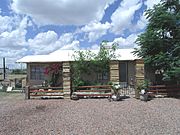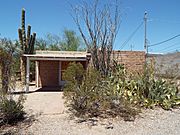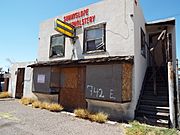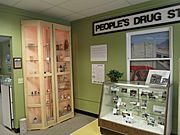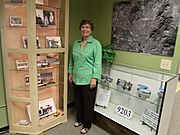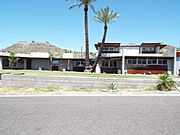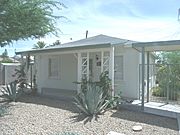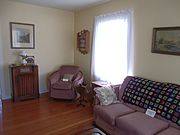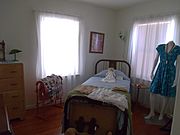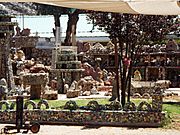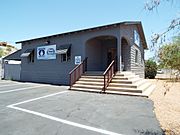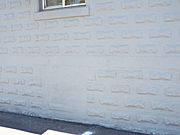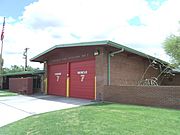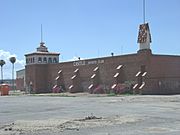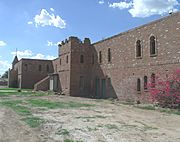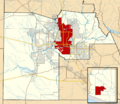Quick facts for kids
List of historic properties
in Phoenix, Arizona
|
|
|

Historic Washington Street
|
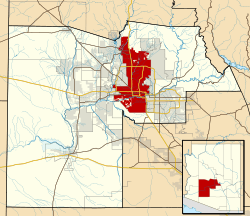
|
This article shares a list of some of the oldest and most important buildings, places, and monuments in Phoenix, Arizona, United States. It includes photos of properties that are special to the history of African, Asian, and Hispanic communities in Phoenix from 1870 to 1975.
This list isn't just about old buildings. It also features historical landmarks. Some of these are even listed on the National Register of Historic Places. For example, the Pueblo Grande Ruin and Irrigation Sites and the Deer Valley Rock Art Center show us ruins and artifacts from the Hohokam people. They lived in the Phoenix area long before other settlers arrived.
Early canals and the Joint Head Dam were super important for bringing water to Phoenix. They helped the city grow in its early days. You'll see pictures of the old Joint Head Dam, built in 1884. Also, there's the Grand Canal from 1877, which is the oldest canal in Phoenix, and the Old Crosscut Canal, built in 1888.
We've also included photos of the burial places of important people from Phoenix and Arizona history. These are in Phoenix's historic cemeteries. A "historic cemetery" means it's been around for more than 50 years. One of the oldest is the Crosscut Cemetery, started in 1870. The Pioneer and Military Memorial Park is also listed as a historic place.
You'll find some museums in Phoenix with images of cool historical items. The Phoenix Trolley Museum shows off the historic Trolley Car #116. The Martin Auto Museum has cars from 1886 onwards. And the Musical Instrument Museum has instruments from all over the world!
Laveen and the Sunnyslope District are listed separately. That's because people in these areas once wanted them to be their own towns. But instead, they became part of the big city of Phoenix.
Phoenix
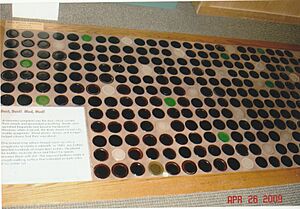
Jim Cotton's Saloon Beer Bottle Sidewalk-1885
Phoenix is the capital and largest city in Arizona. It became a city in 1881. Phoenix was founded in 1867 near the Salt River. The city has many historic properties. Some are listed on the National Register of Historic Places. There are also 33 special places called "Phoenix Points of Pride." These are the city's best features. The Phoenix Historic Property Register was started in 1986. It lists historic places the city wants to protect. Some properties are on both lists.
Historic Heritage Square is in downtown Phoenix. It has the only remaining old homes from Phoenix's first town site. You'll see pictures of these homes with short descriptions.
Vanishing Phoenix
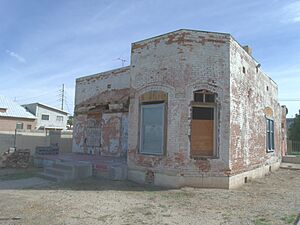
The Clinton Campbell House
Sadly, some historic places in Phoenix have been lost. Even if a building is on a historic list, its owner can sometimes tear it down. Whole neighborhoods, like Golden Gate, have been removed. For example, the home of former Governor Joseph Kibbey was demolished. So was the building where Arizona's first African-American doctor, Winston C. Hackett, had his practice and founded a hospital. The historic St. James Hotel was also torn down. This happened even though groups wanted to save it. It was replaced by a parking lot for the Phoenix Suns basketball team.
Here are some other historic places that were once listed but have been demolished:
- Arizona Citrus Growers Association Warehouse (1920s)
- Concrete Block House (early 1900s)
- Higuera Grocery (1900s)
- Lightning Delivery Co. Warehouse (1920s)
- Overland Arizona Co. (1910s)
- Judge W. H. Stillwell House (1910s)
- Clinton Campbell House (1895)
Some historic homes and buildings are on a list called the "enDangered Dozen Historic Places List." These places are at high risk of disappearing. They might be damaged by weather or vandalism. Here are a few examples:
- The Steinegger Lodge (1889)
- The William R. Norton House (1895)
- The Charles Pugh House (1897)
- The Louis Emerson House (1902)
- The Concrete Block Bungalow (1908)
- The Leighton G. Knipe House (1909)
- The Sach's-Webster Farmstead House (1909)
- The Sarah Pemberton House (1920)
- Mrs. Neal House (1920)
Pueblo Grande Ruin
The Pueblo Grande Ruin is what's left of a very old Hohokam village. It dates back to 450 BC. For unknown reasons, the Hohokam people left the site around 1450 AD. Today, you can see some of these ancient ruins. They are part of the Pueblo Grande Museum & Archaeological Park.
- Historic Pueblo Grande Ruins in Phoenix, Arizona
Listed in the National Register of Historic Places
-
Pueblo Grande Ruin National Historic Landmark Marker.
-
-
Artifacts displayed inside the Pueblo Grande Ruin-Museum.
-
Display inside the Pueblo Grande Ruin Museum.
-
Hohokam leaders lived in houses surrounded by mounds.
-
On the summer and winter solstices, sunlight shines through doorways. This marks the middle of the solar year.
-
Tools and weapons were stored in these rooms.
-
These large rooms had eight-foot walls. Artifacts were kept here.
-
Miller's Room is named after Dr. Joshua Miller. He led the first excavation of the ruins in 1901.
-
This is the largest mound at the Pueblo Grande Ruin.
-
This shows what a Hohokam house looked like 700 years ago.
-
Inside view of the Adobe Compound Replica.
-
Artifacts inside the Adobe Compound Replica.
-
These show what Hohokam pit houses looked like 1000 years ago.
-
This was a Hohokam ballpark for ceremonial games. Villagers watched from the surrounding mound.
-
These mesquite kitchens were used by the O'odham people in the 1600s. They are believed to be Hohokam descendants.
-
The Hohokam community shared these ovens.
-
A partial view of the Hohokam Village.
-
Another view of the Hohokam Village.
-
The Old Crosscut Canal was built in 1888 by pioneers. It is next to an ancient Hohokam canal.
The Joint Head Dam and canals
When early settlers came to Phoenix, it was mostly desert. People like Jack Swilling were inspired by the old Hohokam canals. Pioneers started digging ditches to bring water from the Salt River to their farms. Later, companies like the Arizona Canal Company (formed in 1882) built more canals. The Joint Head Dam was built in 1884. It helped water flow into the Grand Canal (1878) and the Old Crosscut Canal (1888). The abandoned Joint Head Dam is important for its role in Phoenix's water history.
- Joint Head Dam, the Grand Canal and the Old Crosscut Canal
-
The ruins of the abandoned Joint Head Dam, built in 1884.
-
More ruins of the abandoned Joint Head Dam.
-
-
Ruins of the front side of the Joint Head Dam.
-
Even more ruins of the abandoned Joint Head Dam.
-
Ruins of the abandoned Joint Head Dam.
-
The dried up Salt River bed leading to the Joint Head Dam.
-
The dry part of the Salt River where the Joint Head Dam's head gate is. This is where Jack Swilling started his "Swillings Ditch."
-
The Grand Canal built in 1878 in Phoenix.
-
The overflow release on the Grand Canal, built in 1878.
-
The other side of the overflow release on the Grand Canal.
-
A different view of the overflow release on the Grand Canal.
-
The Old Crosscut Canal built next to the Pueblo Grande Ruin.
-
The Old Crosscut Canal was built in 1888.
-
Another view of the 1888 Old Crosscut Canal.
Heritage Square
Phoenix's Heritage Square is a special place. It was once Block 14 of the original Phoenix townsite. The square dates back to the late 1800s, the Victorian era. The area was listed as historic in 1978. The Dr. Roland Lee Rosson House (1895) is here. It's now a museum showing what homes were like back then. The Baird Machine Shop (1920) is also in the square. Both are listed as historic places.
- Historic Phoenix Heritage Square
-
The Dr. Roland Lee Rosson House was built in 1895. It's at 139 N. 6th Street. It was added to the National Register of Historic Places in 1971.
-
The Rosson Carriage House was built in 1899.
-
The Baird Machine Shop was built in 1920. It's now part of Heritage Square. It was listed in 1985.
-
The Hughe's-Stevens Duplex was built in 1923.
-
The Forest Burgess Carriage House built in 1881.
-
The Stevens House built in 1901.
-
The Bouvier Teeter House built in 1899.
-
The Thomas House was built in 1909.
-
The Stevens-Haugsten House was built in 1901.
Buildings and structures
This section shows historical buildings in Phoenix. They are listed on the National Register of Historic Places (NRHP) or the Phoenix Historic Property Register (PHPR). The oldest standing building still in use is the "Fry's Building" from 1885. The "Windsor Hotel" (1893) is the oldest hotel still open.
You'll also see other historic structures. These include the "Heard Ranch Grain Silos" and the Arizona State Fair Grandstand. The "17th Avenue Underpass" and "Central Avenue Underpass" are also important.
- Historic buildings in Phoenix, Arizona
(NRHP = National Register of Historic Places)
(PHPR = Phoenix Historic Property Register)
-
What remains of the Phoenix Bakery building. It was built in 1881. In 2019, it was moved to the Phoenix Zoo.
-
The Fry's Building was built in 1885. It is listed in the NRHP.
-
The Steinegger Lodging House was built in 1889. It was demolished in 2020.
-
The Phoenix Building and Loan house was built in 1890. It is listed in the NRHP.
-
The Windsor Hotel was completed in 1893. It is listed in the NRHP.
-
The service desk of the historic Windsor Hotel.
-
The lobby of the historic Windsor Hotel.
-
The Phoenix Cotton Oil Company Building was built in 1895. It is listed in the PHPR.
-
Historic Prescott and Eastern Railroad Depot built in 1898. It was moved to Phoenix and is now part of a home.
-
Arvizu's El Fresnal Grocery Store was built in 1900. It is listed in the NRHP.
-
Yaun Ah Gim Groceries was built in 1900. It is listed in the NRHP.
-
The Arizona State Hospital Building was built in 1900. It is listed in the NRHP.
-
The Arizona State Capitol building was built in 1900. It is listed in the NRHP.
-
Phoenix Seed and Feed Warehouse built in 1905. It is the oldest warehouse in original Phoenix. Listed in the NRHP.
-
The originalGreenwood Memorial Park Crematorium built in 1906.
-
The Phoenix Carnegie Library was built in 1907. It is listed in the NRHP.
-
The Del Monte Market built in 1908. It is the oldest continuously operating market in Arizona. Listed in the PHPR.
-
The Valley Machine Works built in 1909.
-
Phoenix Volunteer Firefighters Monument built in 1910.
-
The Gas Works building was built in 1910. It is listed in the PHPR.
-
The Swindall Tourist Inn was built in 1913. It was the only known African-American boarding house in Phoenix during segregation. Listed in the NRHP.
-
The Wakelin (E.S.) Grocery Company Warehouse was built in 1913. It is listed in the PHPR.
-
The Jefferson Hotel was built in 1915. It is now the Phoenix Police Museum. Listed in the PHPR.
-
The Durand Grocery building was built in 1916. It is listed in the NRHP.
-
The Phoenix Elementary School District #1 Administration Building was built in 1917. It is listed in the PHPR.
-
The Luis Lugo Bakery "La Patellera" was built in 1917. It is one of the earliest Hispanic commercial properties. Listed in the PHPR.
-
Another view of the Luis Lugo Bakery.
-
The Southwest Cotton Co./Karlson Machine Works building was built in 1918. Listed in the PHPR.
-
The Gem and Mineral Building built in 1918 on the Arizona State Fairgrounds. It is the oldest building there. Listed in the PHPR.
-
The side wall of the Gem and Mineral Building.
-
A close-up view of the Gem and Mineral Building.
-
Inside the Gem and Mineral Building.
-
The Tovrea Land and Cattle Co. Administration Building was built in 1919. It is now the Stockyards Restaurant. Listed in the PHPR.
-
J.W. Walker Building was built in 1920. It is listed in the NRHP.
-
Front view of the J.W. Walker Building.
-
The Corpstein Duplex was built in 1920. It is listed in the PHPR.
-
The Cole Mansion and Baker House were built in the 1920s. They are now connected and house a restaurant. Listed in the PHPR.
-
The Dr. Shackelford Dental Office Building now has a small exhibit of the Arizona Street Railway Museum. Listed in the PHPR.
-
The Constable Ice and Fuel Co. building (now The Ice-house) was built in 1920. It is now an arts center. Listed in the NRHP.
-
The Heard Building was built in 1920. It was Phoenix's first skyscraper. It appeared in the 1960 film "Psycho." Listed in the NRHP.
-
Rehbein Grocery built in 1920. Listed in the NRHP.
-
El Zaribah Shrine Auditorium was built in 1921. It is now the Polly Rosenbaum Building. Listed in the NRHP.
-
Arizona Compress and Warehouse Co. Warehouse built in 1922. Listed in the NRHP.
-
Another view of the Arizona Compress and Warehouse Co. Warehouse.
-
The Chambers Storage Building was built in 1923. It is listed in the NRHP.
-
The Chambers Transfer and Storage Central Warehouse was built in 1923. It is listed in the NRHP.
-
The Phoenix Union Station was built in 1923. It is listed in the NRHP.
-
Another view of the historic Phoenix Union Station.
-
The Brickhouse Warehouse Building was built in 1924.
-
Another view of the Brickhouse Warehouse Building.
-
The Luhrs Building is a ten-story building built in 1924. It is listed in the NRHP.
-
The Wing F. Ong Grocery Store built in 1925. Wing F. Ong was the first Chinese American elected to a state legislature.
-
The Hurley Building was built in 1925. It is listed in the NRHP.
-
The Copeland & Trachet Service Station was built in 1925. It is now Granpa Sal's Tires. Listed in the NRHP.
-
Bragg's Pie Building was built in 1925. It is listed in the NRHP.
-
Front of Bragg's Pie Building.
-
The Valley Plumbing and Sheet Metal Building was built in 1925. It is listed in the NRHP.
-
The Shell Oil Company Warehouse was built in 1925. It is listed in the NRHP.
-
Western Wholesale Drug Company Warehouse built in 1925. It is owned by rock legend Alice Cooper and houses his restaurant. Listed in the PHPR.
-
The Security Building was built in 1925. It is listed in the NRHP.
-
The Anchor Manufacturing Co. was built in 1925. It is listed in the NRHP.
-
Another view of the Anchor Manufacturing Co..
-
The San Carlos Hotel was built in 1925. Many celebrities like Mae West and Clark Gable stayed here. Listed in the NRHP.
-
The Firestone building built in 1925. It is listed in the NRHP.
-
The Pay n Takit #13 was built in 1925. It is listed in the NRHP.
-
The Verde Park Pumphouse was built in 1925. It is listed in the NRHP.
-
The Arizona Sash, Door & Glass Company Warehouse was built in 1926. It is listed in the PHPR.
-
Hotel St. James was built in 1925. It was demolished in 2012.
-
Mobile Gas Station built in 1926. It now houses "The Old Station Subs."
-
The Phoenix Masonic Temple was built in 1926. It is listed in the PHPR.
-
The Pay'n Takit No. 25 was built in 1926. It is listed in the NRHP.
-
The A.E. England Motors Building was built in 1926. It is listed in the PHPR.
-
J.T. Whitney Funeral Chapel built in 1926. It is listed in the NRHP.
-
The Welnick Arcade Grocery Store building was built in 1927. It is listed in the NRHP.
-
An ornament on the Welnick Arcade Grocery Store building.
-
The Pay n Takit #5 was built in 1927. It is listed in the NRHP.
-
The Barbara Jean Apartments was built in 1927. It is listed in the PHPR.
-
The Blake, Moffitt, Towne Janitorial Co. Warehouse built in 1927. Listed in the PHPR.
-
The C. P. Stephans De Soto Six Motor Cars building was built in 1927. It is listed in the NRHP.
-
The Gold Spot Shopping Center built in 1925. It is in the Roosevelt Historic District.
-
Another view of the Gold Spot Shopping Center.
-
The Arizona Museum building was built in 1927. It is listed in the PHPR.
-
The Orpheum Theatre was built in 1927. It is listed in the NRHP.
-
Orpheum Theatre ornament.
-
Knights of Pythias Building built in 1928. It is listed in the NRHP.
-
Front entrance of the Knights of Pythias Building.
-
J.B. Bayless Store No. 7 built in 1928. It is listed in the NRHP.
-
Central Arizona Light & Power Co. Warehouse built in 1928. Listed in the PHPR.
-
-
Maricopa County Courthouse built in 1928. Famous trials like Winnie Ruth Judd's were held here. The "Miranda rights" were also established here. Listed in the NRHP.
-
Phoenix-Building-Maricopa County Courthouse Jail-1929-2.jpg
Maricopa County Jail where famous people were once held.
-
The 1931 Jack and Trinidad Swilling plaque.
-
Gerardo's Building built in 1928. It once housed a café. Listed in the NRHP.
-
Jim Ong's Market built in 1928. It also served as the Ong family home. Listed in the NRHP.
-
The Stapley (O.S.) Company Building was built in 1928. It is listed in the NRHP.
-
The Fuller (W.P.) Paint Company Warehouse was built in 1929. It is listed in the PHPR.
-
The Phoenix Linen & Towel Supply Company Warehouse was built in 1929. It is listed in the PHPR.
-
Brown's Pharmacy was built in 1929. It is listed in the NRHP.
-
Luhrs Tower built in 1929. It appeared in the 1960 film "Psycho." Listed in the NRHP.
-
The Sun Mercantile Building was built in 1929. It is the last warehouse in what was Phoenix's Chinatown. Listed in the NRHP.
-
The Santa Fe Freight Depot was built in 1929. It is listed in the PHPR.
-
The front entrance of the Heard Museum building, built in 1929. It is listed in the PHPR.
-
The Heard Museum building was built in 1929. Maie Heard helped guide the museum's activities. Listed in the PHPR.
-
The Heard Ranch Grain Silos were built in 1930. They are on the Legacy Resort golf course. Listed in the PHPR.
-
In the 1930s, this was a Phoenix Airport hangar and terminal. Ruth Reinhold was the first female pilot in Arizona here.
-
The Greystone Apartments was built in 1930. It is listed in the PHPR.
-
Another view of the Greystone Apartments.
-
The General Electric Supply Warehouse was built in 1930. It is listed in the PHPR.
-
Department of Agriculture Building built in 1930. It is listed in the PHPR.
-
The Arizona State Fair Grandstand was built in the early 1900s.
-
Another view of the Arizona State Fair Grandstand.
-
The Ong Yut Geong Market Warehouse was built in 1930. It is listed in the NRHP.
-
Arizona Hardware Supply Company Warehouse built in 1930. Listed in the PHPR.
-
The Bobby Brown Café building was built in 1930. It is listed in the PHPR.
-
The Wakelin (E.S.) Grocery Company Warehouse was built in 1930. It is listed in the PHPR.
-
This building, built in 1930, once housed the Living Room Lounge. Boxer Tony DeMarco owned it.
-
The Day (Dud R.) Motor Company building was built in 1930. It is listed in the PHPR.
-
The Wastewater Treatment Plant Control Building was built in 1931. It is listed in the PHPR.
-
The Stag Hotel / Patio Hotel was built in 1931. It now houses a Chinese Restaurant. Listed in the PHPR.
-
The Phoenix Title and Trust Towers were built in 1931. They are listed in the NRHP.
-
Entrance of the Lois Grunow Memorial Clinic, built in 1931. It is listed in the NRHP.
-
The Professional Building built in 1931. It is listed in the NRHP.
-
The U.S. Post Office / Federal Building was built 1932–1936. It is listed in the PHPR and NRHP.
-
The Cobb Bros. Market Warehouse built in 1932. Listed in the PHPR.
-
The University Park Bath (Pool) House was built in 1934. It is listed in the PHPR.
-
The 17th Avenue Underpass built in 1935. It is a good example of Depression-era bridge building.
-
The Encanto Park Clubhouse was built in 1936. It is listed in the PHPR.
-
The Arizona Army National Guard Arsenal was built in 1936. It now houses the Arizona Military Museum. Listed in the NRHP.
-
The original adobe walls inside the Arizona Army National Guard Arsenal building.
-
The Hunt Bass Hatchery Caretaker's House was built in 1936. It is on the Phoenix Zoo grounds. Listed in the NRHP.
-
The Neighborhood House was built in 1937. It is listed in the PHPR.
-
The Merryman Funeral Home was built in 1937. It is listed in the PHPR.
-
The Squaw Peak Inn was built in 1937. Celebrities like June Allyson stayed here. Listed in the NRHP.
-
King's Rest Hotel Motor Court was built in 1937. It is listed in the NRHP.
-
This motel started as the Arrow Motel in 1937. It is listed in the PHPR.
-
The Arizona State Fair WPA Civic Building was built in 1938 during the Great Depression.
-
The front entrance of the Arizona State Fair WPA Civic Building.
-
The Webster Auditorium was built in 1939 inside the Desert Botanical Garden. It is listed in the NRHP.
-
Inside the Webster Auditorium.
-
The Arizona State Fair Home Economics Building was built in 1940. It is in danger of being torn down.
-
Close up view of the Arizona State Fair Home Economics Building.
-
The only remaining courtyard of the Matthew Henson Public Housing Project. It provided homes for African-Americans. Listed in the PHPR.
-
The Central Avenue Underpass was built in 1940. It is listed in the PHPR.
-
The Crippled Children's Hospital was built in 1941. It is listed in the PHPR.
-
The Phoenix Housing Authority Building was built in 1941. It is listed in the PHPR.
-
The Good Shepherd Home for Girls was built in 1942. It is now a commercial property. Listed in the PHPR.
-
The Pohle Dry Cleaning Building was built in 1946. It has a modern international style.
-
The General Sales Co. building was built in 1946. It is listed in the NRHP.
-
Hanny's was built in 1947. It is listed in the NRHP.
-
The Graham Paper Company Warehouse was built in 1949. It is listed in the PHPR.
-
The Medical Center building was built in 1949. It now houses Summit Elementary School.
-
The Farmers & Stockmens Bank was built in 1950–1951. It is listed in the PHPR.
-
The original Sky Harbor Air Traffic Control Tower was built in 1952. It was moved in 1991.
-
Close up view of the original Sky Harbor Air Traffic Control Tower.
-
The Progressive Builders Association Building was built in 1953. It helped African Americans buy new homes. Listed in the PHPR.
-
The Crown Filter Queen Building was built in 1955. It is listed in the NRHP.
-
The Produce Center Building was built in 1956. It is listed in the PHPR.
-
The Paris Laundry and Dry Cleaning Building was built in 1957. It has a cool Googie style.
-
The Phoenix Towers were built in 1957. They are a great example of mid-century architecture. Listed in the NRHP.
-
Front view of the Phoenix Towers.
-
The Sacred Heart House for the Aged was built in 1958. It is listed in the NRHP.
-
The 300 Bowl building (now AMF Christown Lanes) was built in 1960. It has a Googie style roof.
-
Another view of the 300 Bowl building.
-
The Conn and Candlin CPA Office was built in 1962. It is listed in the NRHP.
-
Side view of the Conn and Candlin CPA Office.
-
The Roman Roads built in 1962. It is listed in the NRHP.
-
-
The Executive Towers were built in 1962. They are listed in the NRHP.
-
The Phoenix Star Theatre (a.k.a. Celebrity Theatre) was built in 1963. It is listed in the PHPR.
-
The Regency House was built in 1964. It is listed in the NRHP.
-
-
-
The Valley National Bank building was built in 1968. It is listed in the PHPR.
-
Another view of the Valley National Bank.
-
Side view of the Valley National Bank.
-
The Vlassis Ruzow and Associates Building was built in 1974. It is listed in the NRHP.
-
Western Savings & Loan Building. This vase-shaped building was built in 1975. It is listed in the PHPR.
-
Inside view of the curved roof of the Western Savings & Loan Building.
Houses of religious worship
Many historic churches in Phoenix are listed on the National Register of Historic Places. For example, the "First Presbyterian Church" (1892). Others, like the "Tanner Chapel A.M.E. Church" (1929), are recognized by the Phoenix Historic Property Register. The Tanner Chapel is one of Arizona's oldest African-American churches. Martin Luther King Jr. gave a sermon there. The "First Mexican Baptist Church" (1920) is Phoenix's oldest Hispanic church. It is also recognized as historic.
- Historic Houses of religious worship in Phoenix, Arizona
(NRHP = National Register of Historic Places)
(PHPR = Phoenix Historic Property Register)
-
The First Presbyterian Church was built in 1892. It is listed in the NRHP.
-
The Sacred Heart Church was built in 1900. It is listed in the NRHP.
-
The Brooks Memorial United Methodist Church was built in 1908. It is now a funeral home.
-
The Saint Mary's Basilica was built in 1914. It is listed in the NRHP.
-
The Trinity Episcopal Cathedral was built in 1915. It is listed in the PHPR.
-
The First Mexican Baptist Church was built in 1920. It is Phoenix's oldest Hispanic church.
-
The Temple Beth Israel was built in 1922. It was Phoenix's first synagogue. It later became a Chinese Baptist Church and a Hispanic church. Listed in the NRHP.
-
The First Baptist Church was built in 1923. It was damaged by fire and is abandoned. Listed in the NRHP.
-
The Shiloh Baptist Church was built in 1924. It is one of the earliest African-American churches in West Phoenix.
-
The Roosevelt Community Church was built in 1925. It is listed in the NRHP.
-
The Phoenix LDS Second Ward Church was built in 1929. It is the oldest LDS chapel in Phoenix. It is now a puppet theater. Listed in the NRHP.
-
The Bethlehem Baptist Church was built in 1925. It is listed in the NRHP.
-
The Garfield Methodist Church was built in 1926. It is listed in the NRHP.
-
The First Missionary Church was built in 1928. It has Mission Revival style. Listed in the PHPR.
-
The Brophy College Chapel was built in 1928. Students of Brophy College built this Spanish Colonial chapel. Listed in the NRHP.
-
The Grace Lutheran Church was built in 1928. It is listed in the NRHP.
-
The Immaculate Heart of Mary Catholic Church was built in 1928. It is Phoenix’ second oldest Hispanic church. Listed in the NRHP.
-
The Tanner Chapel A.M.E. Church was built in 1929. It is the oldest African-American church in Arizona. Listed in the PHPR.
-
The Arizona Buddhist Temple built in 1930. It was the first of its kind in Arizona.
-
The St. Pius X Catholic Church was built in 1935. It is listed in the PHPR.
-
The Mennonite Church Meetinghouse was built in 1946 in Sunnyslope. It is listed in the PHPR.
-
The South Mountain Community Church was built in 1944. It is listed in the PHPR.
-
The Mount Calvary Baptist Church was built in 1944. It is one of the earliest churches for the African-American community.
-
The Faith Lutheran Church was built in 1946. It is listed in the PHPR.
-
The Primera Iglesia Metodista (First Methodist Church) was built in 1947. It is recognized as historic by the Hispanic American Historic Property Survey.
-
The Lucy Phillips Memorial C.M.E. Church was built in 1947 by the African-American community. It is listed in the PHPR.
-
The St. Anthony Church was built in 1948. It is recognized as historic by the Hispanic American Historic Property Survey.
-
The Sunnyslope Presbyterian Church was built in 1949. It is listed in the PHPR.
-
The building that once housed the historic Iglesia Betania Presbiteriana was built in 1950. It is recognized as historic.
-
The Pavilion of Light of the Phoenix First Assembly of God was built in the 1980s. It is a very large church.
Educational institutions
Phoenix's first school, the Little Adobe School, opened in 1873. It was at 202 N. Central Avenue. Back then, schools were segregated. This meant students of different races went to separate schools. The Phoenix Indian School (1891) was part of a policy to change Native American students' culture. African-American students attended schools like Dunbar School (1925), Phoenix Union Colored High School (1926), and Booker T. Washington Elementary School (1928).
- Historic educational institutions in Phoenix, Arizona
(NRHP = National Register of Historic Places)
(PHPR = Phoenix Historic Property Register)
-
The Phoenix Indian School main building was built in 1891. It is listed in the NRHP.
-
Another view of the Phoenix Indian School.
-
Phoenix Union High School was built in 1912. It is listed in the NRHP.
-
Phoenix Union High School Domestic Arts building was built in 1912. It is listed in the NRHP.
-
Phoenix Union High School Auditorium was built in 1912. It is listed in the NRHP.
-
Phoenix Union High School Science building was built in 1912. It is listed in the NRHP.
-
Monroe High School was built in 1914. It is listed in the NRHP.
-
The Phoenix Elementary School District #1 Administration Building was built in 1917. It is listed in the PHPR.
-
The McKinley School was built in 1919. It is listed in the PHPR.
-
The Kenilworth School was built in 1919. It is listed in the NRHP.
-
The current Cartwright School was built in 1921. It is listed in the NRHP.
-
The original 1910 Cartwright School bell.
-
Phoenix Indian School Memorial Hall was built in 1922. It is listed in the NRHP.
-
Adams School (now Grace Court School) was built in 1924. It is listed in the NRHP.
-
Franklin High School was built in 1925. It is listed in the NRHP.
-
Dunbar School was built in 1925. It is listed in the NRHP.
-
Phoenix Union Colored High School (later George Washington Carver High School) was built in 1926. It is listed in the NRHP.
-
The Booker T. Washington Elementary School was built in 1928. It was the first all African-American elementary school. It is listed in the PHPR.
-
The Arizona Academy North and South Halls were built in 1928. They are now called Stepping Stone Place. Listed in the NRHP.
-
The John G. Whittier School was built in 1929. It is listed in the NRHP.
-
The Indian School Band Building built in 1931. It is listed in the NRHP.
-
North Phoenix High School (now North High School) was built in 1939. It was financed by New Deal programs.
19th century historic houses
These houses are important because of their history and architecture. They are connected to people who played a big part in Phoenix's past. Some of these homes are listed on the National Register of Historic Places or the Phoenix Historic Property Register.
Here are some of the important people who lived in these houses:
- Clinton Campbell: A well-known builder in Phoenix. His house was sadly torn down in 2017.
- Phillip "Lord" Darrell Duppa: He is credited with naming "Phoenix" and "Tempe."
- Burgess A. Hadsell: He helped create the town of Glendale, Arizona.
- William John Murphy: He started the Arizona Improvement Company and bought land for Peoria and Glendale.
- William R. Norton: He founded the Sunnyslope area of Phoenix. He also designed the Carnegie Library.
- William Osborn: One of Phoenix's first homesteaders.
- Judge Charles A. Tweed: He served as a judge in Arizona Territory.
- Historic houses built in the 19th century in Phoenix, Arizona
(NRHP = National Register of Historic Places)
(PHPR = Phoenix Historic Property Register)
-
The Duppa-Montgomery Adobe House was built in 1870. It is one of Phoenix's oldest houses.
-
The Jones-Montoya House was built in 1879. It is one of Phoenix's oldest houses. It was the home of "Lord" Darrell Duppa. Listed in the PHPR.
-
The Judge Charles A. Tweed House was built in 1880. Judge Tweed was an important judge. Listed in the PHPR.
-
The House at 818 South 1st Avenue was built in 1885. It is listed in the NRHP.
-
The Eyrich-Kohl House was built in 1885. Eyrich was a German immigrant and plumber. Listed in the NRHP.
-
The William Lewis Osborn House was built in 1890. William Osborn was one of Phoenix's first homesteaders. Listed in the NRHP.
-
An abandoned Victorian House built in 1890.
-
The M.J. Sharp House was built in 1890. It is listed in the NRHP.
-
The Burgess A. Hadsell House was built in 1893. Hadsell helped found Glendale. Listed in the NRHP.
-
The Oscar Roberts Madison House was built in 1893. Listed in the PHPR.
-
The Dr. Evans' House was built in 1893. Dr. John M. Evans used it as a home and office. Listed in the NRHP.
-
The C. P. Cronin House was built in 1893. Listed in the PHPR.
-
The Eder-Moffitt House was built in 1894. It is listed in the NRHP.
-
The Clinton Campbell House was built in 1895. It was demolished in 2017.
-
The H.M. Coe House was built in 1895. Coe was a mechanic. Listed in the NRHP.
-
The William R. Norton House was built in 1895. Norton founded Sunnyslope. Listed in the PHPR.
-
The William J. Murphy House was built in 1895. William J. Murphy helped develop Peoria and Glendale. Listed in the PHPR.
-
The Anderson-Joannes House was built in 1895. It is listed in the NRHP.
-
The George Hidden House was built in 1896. It is listed in the NRHP.
-
The Charles Pugh House was built in 1897. Listed in the PHPR.
-
The Smurthwaite House was built in 1897. It is now the office for the historic Pioneer and Military Cemetery. Listed in the NRHP.
-
The living room of the Smurthwaite House.
-
The staircase in the Smurthwaite House.
-
The George Cisney House was built in 1897. It is listed in the NRHP.
-
The O.C. Thompson House was built in 1897. It is now office spaces. Listed in the PHPR.
-
The E. W. Skinner House was built in 1899. Skinner was a local contractor. Listed in the NRHP.
-
The C. A. Larson House was built in 1899. It is listed in the NRHP.
-
The W. E. Adams House was built in 1899. It is listed in the NRHP.
-
The Dougherty-Peterson House was built in 1899. Listed in the PHPR.
-
The William & Nathalie Pinney House was built in 1899. It is listed in the PHPR.
20th century historic houses
Many important people lived in these Phoenix homes. Their houses are listed here.
- Dr. Charles "Charley" Borah: An American athlete who won a gold medal in the 1928 Summer Olympics.
- Jorgine Slettede Boomer: Her house was designed by the famous architect Frank Lloyd Wright.
- Dr. George Brockway: A physician and former Mayor of Florence.
- L. Ron Hubbard: The founder of Scientology.
- John McCain: A U.S. Senator from Arizona and presidential candidate.
- Colonel James McClintock: A veteran and Arizona's state historian. He also helped start a newspaper.
- Dr. James C. Norton: The territorial veterinarian.
- Wing F. Ong: The first person born in China elected to a state legislature.
- Henry E. Pierce: A county official and real estate partner.
- Aubrey and Winstona Aldridge: Winstona was the daughter of Dr. Winston Hackett, the first African-American doctor in the area.
- William Wrigley, Jr.: The chewing-gum magnate. His mansion is known as "La Colina Solana."
Historic African, Asian and Hispanic properties
The City of Phoenix has studied historic properties related to African, Asian, and Hispanic communities. These studies looked at history from 1870 to 1975. The goal was to find and document important places for these groups. The studies also included places important to the fight for civil rights and equality.
The African American Historic Property Survey covered areas like East Phoenix (south of Van Buren Avenue), West Phoenix (south of Grant Avenue), and South Phoenix (south of the Salt River).
Asian American historic properties are found all over Phoenix. Their locations depend on the nationality, like Chinese, Japanese, Filipino, and Asian Indian.
The Hispanic American Historic Property Survey covered areas south of the Southern Pacific Railroad tracks to the Salt River, and other parts of Phoenix. One important building is the Sacred Heart Church (1900). It's in what was once a Hispanic neighborhood called "Golden Gate." The city made residents move and tore down the neighborhood to expand Sky Harbor Airport. The church was added to the National Register of Historic Places in 2012.
Here are some important people from these communities whose homes are listed:
African Americans
- Judge Hazel Burton Daniels: The first African American elected to the Arizona legislature. She was also Phoenix's first African-American municipal judge.
- Dr. Lincoln Johnson Ragsdale Sr. and Eleanor D. Ragsdale: Important leaders in the Phoenix Civil Rights Movement. They helped end segregation in schools and housing.
- Charles Smith: The only African-American blacksmith in Phoenix in the early 1920s.
- John Ford Smith: The only Arizonan known to have played in the national Negro Baseball Leagues. He was also active in civil rights.
- Travis L. Williams: He helped found a construction company that built homes in South Phoenix. He also worked for the City of Phoenix.
- Historic African-American Properties
(including buildings, schools, churches and homes)
National Register of Historic Places=(NRHP)
-
Eastlake Park is bounded by 15th, 16th, Jefferson, and Jackson streets. Important civil rights leaders spoke here. Listed in the PHPR.
-
The Swindall Tourist Inn was built in 1913. It was the only known African-American boarding house in Phoenix during segregation. Listed in the NRHP.
-
The Charles Smith Blacksmith Shop was built in the early 1920s.
-
An African-American home built in 1920.
-
The Shiloh Baptist Church built in 1924. It is one of the earliest African-American churches in West Phoenix.
-
The Dunbar School was built in 1925. It is listed in the NRHP.
-
The Phoenix Union Colored High School (later George Washington Carver High School) was built in 1926. It is listed in the NRHP.
-
The Booker T. Washington School was built in 1928. It was the first all African-American elementary school. It is listed in the PHPR.
-
Another view of the Booker T. Washington School.
-
The Tanner Chapel A.M.E. Church was built in 1929. It is the oldest African-American church in Arizona. Listed in the PHPR.
-
Three of the six cottages that Dr. Winston C. Hackett built in the 1930s for his patients.
-
The W.A. Robinson House was built in 1935. Robinson was a principal at an African-American school.
-
Entrance to where the historic Matthew Henson Public Housing Project once stood. It provided affordable housing.
-
One of the original houses in the Matthew Henson Public Housing Project courtyard.
-
The Dr. Lincoln Johnson Ragsdale, Sr. House was built in 1941.
-
This building housed Gordon Fritch Cafe in 1944. It was a popular spot for African Americans.
-
The Mount Calvary Baptist Church was built in 1944. It is one of the earliest churches for the African-American community.
-
The Bethel CME Church was built in 1944.
-
The St. John's Institutional Baptist Church was built in 1944. Rev. L.J. Dunbar led this church.
-
The Geogie M. & Calvin C. Goode Bandshell was built in 1945 in Eastlake Park. Activists spoke here. Listed in the PHPR.
-
The Robert and Louise Phillips House was built in 1946. The Phillips family helped with school desegregation.
-
The William H. Patterson Elks Lodge No. 477 was built in 1946 by the African-American community. Listed in the PHPR.
-
The Lucy Phillips Memorial C.M.E. Church was built in 1947. It is listed in the PHPR.
-
The Hazel Burton Daniels House was built in 1947.
-
The Mary McLeod Bethune School was built in 1947. It was a segregated school for the growing Black community.
-
This building housed the Westside Theater in 1948. It was the first theater owned by an African American in Arizona.
-
The Greater Friendship Missionary Baptist Church was built in 1949.
-
The Higher Ground Church of God in Christ was built in 1949.
-
The Dr. Lowell Wormley House was built in 1949. Dr. Wormley was one of few African-American doctors in Phoenix. Listed in the PHPR.
-
The Aldridge House was built in 1950. It was the home of Winstona Hackett and Aubrey Aldridge. Listed in the PHPR.
-
The Progressive Builders Association Building was built in 1953. It helped African Americans buy homes. Listed in the PHPR and NRHP.
-
The Southminster Presbyterian Church was built in 1954. It was the only African-American Presbyterian church in Phoenix at the time.
-
The Morrison E. Warren House was built in 1956. Morrison E. Warren was the first African American elected to the Phoenix City Council.
-
The Calvin and Georgie Goode Duplex House was built in 1959. Calvin Goode was a City Councilman, and Georgie Goode was a Civil Rights leader.
-
Part of the Calvin and Georgie Goode Duplex House where the Ragsdales once lived.
-
The John Ford Smith House built in 1959.
-
The Travis Williams House built in 1959.
Asian Americans
- Dea Hong Toy: Born in China, he was a successful merchant in Phoenix. He helped found the Chinese Chamber of Commerce.
- Wing F. Ong: He lived behind his grocery store. He was the first Chinese American elected to a state legislature in the U.S.
- Lee Jew: A Chinese merchant and leader in the Phoenix Chinese community.
- Historic Asian-American Properties
(including buildings, schools, churches and homes)
National Register of Historic Places=(NRHP)
-
The Yaun Ah Gim Groceries was built in 1900. It is listed in the NRHP.
-
The Kunz-Carbajal House was built in 1904. Felix Carbajal was one of the first Filipino residents.
-
The K.S. Tang Grocery building was built in 1914. It is recognized as historic. Listed in the NRHP.
-
The Roland's Market building was built in 1917. It is recognized as historic.
-
The Temple Beth Israel was built in 1922. It was Phoenix's first synagogue and later a Chinese Baptist Church. Listed in the NRHP.
-
The Wing F. Ong Grocery Store built in 1925.
-
The building where Henry & Co. was once housed was built in 1928. It is recognized as historic.
-
The Jim Ong's Market was built in 1928. It also served as the Ong family home. Listed in the NRHP.
-
Another view of Jim Ong's Market.
-
The Ong Yut Geong Market Warehouse was built in 1930. It is listed in the NRHP.
-
The Arizona Buddhist Church/Temple built in 1930. It was the first Buddhist church in Arizona.
-
The Lee Jew Market building was built in 1931. It is listed as historical.
-
The T and T Market building was built in 1939. It is recognized as historic.
-
The K.L. Tang Grocery building was built in 1942. It is recognized as historic.
-
The Modern Food Market building was built in 1948. It is recognized as historic.
-
The South Phoenix Market building was built in 1948. It is recognized as historic.
-
The Dea Hong Toy House was built in 1954. Dea Hong Toy was a successful merchant. It is recognized as historic.
Hispanic/Latin-Americans
- Vincente Canalez: He served on Phoenix's planning commission and later as mayor of Buckeye.
- Valdemar Aguirre Cordova: The first Mexican American Maricopa County Superior Court judge.
- Jesus Franco: He led the Spanish-language newspaper El Sol.
- Albert and Mary Garcia: Albert Garcia was Arizona's first Hispanic Assistant Attorney General. María García was an activist.
- Placida Garcia Smith: She founded the "Friendly House" to help Mexican immigrants.
- Rudolf Zepeda: The first Hispanic official at Valley National Bank.
- Adam Perez Diaz: The first Hispanic elected to the Phoenix City Council.
- Historic Hispanic-American Properties
(including buildings, schools, churches and homes)
National Register of Historic Places=(NRHP)
-
The Jones-Montoya House was built in 1879. It is one of Phoenix's oldest houses. Listed in the PHPR.
-
The Sotelo-Heard Cemetery was established in 1896. Many Mexican laborers were buried here. It is listed in the PHPR.
-
The Rancho Joaquina House was built in 1900. It is listed in the NRHP.
-
The Sacred Heart Church built in 1900. It is listed in the NRHP.
-
The Arvizu's El Fresnal Grocery Store was built in 1900. It is listed in the NRHP.
-
The Del Monte Market was built in 1908. It is the oldest continuously operating market in Arizona. Listed in the PHPR.
-
Another view of Del Monte Market.
-
The Pete Romo House was built in 1913. Pete Romo owned a butcher shop. It is part of the Garfield Historic District.
-
The Luis Lugo Bakery "La Patellera" was built in 1917. It is one of the earliest Hispanic commercial properties. Listed in the PHPR.
-
The First Mexican Baptist Church was built in 1920. It is Phoenix's oldest Hispanic church.
-
The Friendly House was built in 1900. It was established in 1922 to help immigrants.
-
The Placida Garcia Smith House was built in 1925. Placida Garcia Smith founded the "Friendly House." It is in the Willo Historic District.
-
The John and Enriqueta House built in 1926.
-
Harmon Park was built in 1927. It is listed in the Phoenix Historic Register.
-
Gerardo's Building built in 1928. It once housed a café. Listed in the NRHP.
-
Another view of Gerardo's Building.
-
The Immaculate Heart of Mary Catholic Church was built in 1928. It is Phoenix’ oldest Hispanic church. Listed in the NRHP.
-
This is the Albert and Mary Garcia House built in 1930. Albert Garcia was Arizona's first Hispanic Assistant Attorney General. It is in the Historic Coronado District.
-
The Valdemar Aguirre Cordova House built in 1930. Cordova was the first Mexican American Maricopa County Superior Court judge.
-
Grant Park was created in 1934 as a WPA project. It was an important place for Mexican American children. Listed in the PHPR.
-
The St. Pius X Catholic Church was built in 1935. It is listed in the PHPR.
-
815 is where Father Emmett McLoughlin started his mission in 1930.
-
The Grant Park Pool building was built in 1944. It served the Hispanic community during segregation.
-
This is where La Estrella Tortilla Shop was once located. The building was built in 1938.
-
The Jesus Franco House was built in 1940. Jesus Franco led a Spanish-language newspaper. It is part of the Roosevelt Historic District.
-
The Rudolf Zepeda House was built in 1940. Rudolf Zepeda was the first Hispanic official at Valley National Bank. It is in the Encanto Historic District.
-
The Marcos de Niza Housing Project was started in 1941.
-
The Adam Perez Diaz House was built in 1942.
-
The American Legion Post #41 was built in 1945. It is listed in the PHPR.
-
Another view of the American Legion Post #41.
-
The Primera Iglesia Metodista (First Methodist Church) was built in 1947. It is listed in the PHPR.
-
Another view of the El Portal restaurant.
-
St. Anthony Church was built in 1948.
-
The building that once housed the Iglesia Betania Presbiteriana was built in 1950.
-
The Vincente Canalez House was built in 1951. Canalez was involved in politics and community.
-
The Santa Rita Center (or Santa Rita Hall) was built in 1962. Cesar Chavez began a hunger strike here. It is listed in the PHPR.
-
A different view of the historic Santa Rita Center.
Arizona Biltmore Hotel
- Arizona Biltmore Hotel
Listed in the National Register of Historic Places
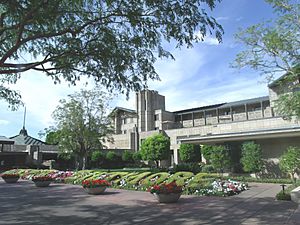
The Arizona Biltmore Hotel is known as the "Jewel of the Desert".
-
-
Arizona Biltmore Hotel bridge.
-
Stylized bricks by architect, Albert Chase McArthur.
-
Inside view of the main entrance of the Arizona Biltmore Hotel.
-
The lobby of the Arizona Biltmore Hotel.
-
The Paradise Wing of the Arizona Biltmore Hotel built in 1929.
-
Mystery Room secret passageway.
-
The fireplace inside the Mystery Room.
-
Stained glass ceiling in the Mystery Room.
-
Spotlight on top of the hotel tower.
-
Room 1201, Clark Gable's room.
-
Inside the Arizona Biltmore Hotel Aztec Room.
-
Inside the Biltmore History Room.
-
The Wooden key on display in the History Room.
-
Furnishings inside the Biltmore History Room.
-
-
The "Legend of the Sun" painting.
-
Large chess board on the grounds. Actress Martha Raye played here.
-
The Arizona Biltmore Hotel Catalina Pool was built in the 1930s. Marilyn Monroe used this pool.
-
Paradise Pool three story water slide.
-
The Reagan honeymoon cottage, Cottage I.
-
The Frank Lloyd Wright "Sprites" statues. They were restored and added to the hotel gardens in 1985.
Arizona State Capitol Museum
- Arizona State Capitol Museum
Listed in the National Register of Historic Places
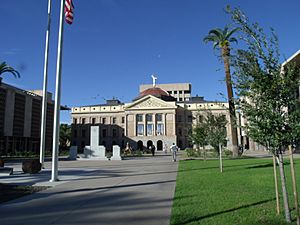
The Arizona State Capitol built in 1901 is now the Arizona State Capitol Museum.
-
Another view of the Arizona State Capitol.
-
The rotunda floor of the Arizona State Capitol Building.
-
Part of the USS Arizona ship, salvaged and on display.
-
The U.S. flag that flew on the USS Arizona when it sank at Pearl Harbor.
-
Silverware donated to the USS Arizona by Arizona citizens.
-
Additional silverware from the USS Arizona.
-
Model of the USS Arizona.
-
The Governor's office with a wax figure of Arizona's first Governor, George W. P. Hunt.
-
The sword and scabbard of Governor Alexander Oswald Brodie.
-
Inside the historic House Chamber.
-
A replica of the original Office of the Secretary of State.
-
View into the original House Chamber from the gallery.
-
View into the original House of Representatives from the gallery.
Bennitt Mansion
- The Bennitt Mansion
Listed in the National Register of Historic Places
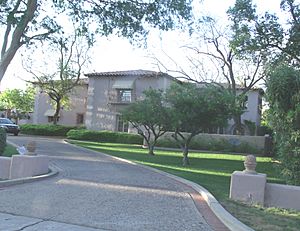
The Bennitt Mansion built in 1928
-
The Bennitt Mansion was built in 1928. It is a great example of Spanish Colonial Revival style. E.J. Bennitt was a key investor in Phoenix banks. Listed in the NRHP.
-
The Bennitt Mansion's arched doorway. It shows special craftsmanship. Listed in the NRHP.
-
Another view of the Bennitt Mansion.
-
Back of the Bennitt Mansion.
Mystery Castle
- Mystery Castle
Listed in the Phoenix Historic Property Register
-
Historic Mystery Castle plaque.
-
Mystery Castle is in the foothills of South Mountain Park. Boyce Luther Gulley built it in the 1930s. It's a Phoenix Point of Pride.
-
Another view of the Mystery Castle.
-
Main entrance of the castle.
-
One of 18 rooms in the castle.
-
Another room in the castle.
-
Mary Lou Gulley's bedroom.
-
Another bedroom in the castle.
-
A window Gulley made from an old car's spoke rim.
-
-
An ornament on a wall outside the castle that looks like a cat.
Scorpion Gulch
-
Scorpion Gulch historical marker.
-
The Scorpion Gulch store was built in 1936 by William Lunsford. It is in South Mountain Park. Listed in the PHPR.
-
Another view of the Scorpion Gulch store.
-
Inside view of the Scorpion Gulch store.
-
The ruins of the Scorpion Gulch residence. Listed in the PHPR.
-
Front view of the ruins of the Scorpion Gulch residence.
-
The main room ruins of the Scorpion Gulch residence.
-
Squaw Peak Inn
- Squaw Peak Inn
Listed in the National Register of Historic Places
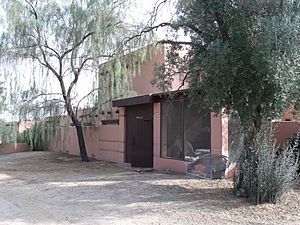
Squaw Peak Inn
(formerly Squaw Peak Ranch)
This is the main building,
it was built in 1937
-
-
The first building built in 1929 by William Eugene D'Allemund.
-
Another view of the first adobe building built in 1929.
-
Main entrance to the historic Inn.
-
A gazebo on the property of Squaw Peak Inn.
-
A room of the original 1937 Squaw Peak Inn building.
-
Another room of the original 1937 Squaw Peak Inn building.
-
One of the rooms inside the historic Squaw Peak Inn.
-
A restored and modernized bathroom inside the historic Squaw Peak Inn.
-
An early 19th-century organ in the main room.
-
Wall decoration created by Ann Epley.
-
View of the outside of the second floor.
-
A room on the second floor.
-
The stairs leading downstairs from the second floor.
Westward Ho Hotel
-
Another view of Westward Ho Hotel. It was built in 1928. Listed in the NRHP.
-
Main entrance of the Westward Ho Hotel. John F. Kennedy gave a speech here in 1960.
-
-
The Grand Dining Room of the Westward Ho Hotel.
-
Side entrance of the Westward Ho Hotel.
Wrigley Mansion
- Wrigley Mansion
Listed in the National Register of Historic Places
-
Pedestrian entrance of the Wrigley Mansion.
-
View from the top of the pedestrian entrance.
-
The main entrance of the Wrigley Mansion.
-
Telephone operator's booth.
-
Wrigley Mansion living room.
-
Inside the main entrance.
-
View from the top of the staircase.
-
Another view from the top of the staircase.
-
-
A room on the second floor.
-
Another room on the second floor.
-
-
Bathroom next to Elvis Presley's room.
-
View from the second floor balcony.
-
View of another staircase.
-
Another view of the Wrigley Mansion.
Central Avenue Corridor
The Central Avenue Corridor in Phoenix has many historic houses and buildings. Some are listed on the National Register of Historic Places, and others are on the Phoenix Historic Properties Register. Some are even on both lists!
- Historic properties in Central Avenue Corridor
Listed in the Phoenix Historic Property Register-July 2004
(NRHP = National Register of Historic Places)
(PHPR = Phoenix Historic Property Register)
-
The David Morgan-Earl A. Bronson House was built in 1927. It is listed in the NRHP.
-
The Asbury-Salmon House was built in 1934. It is listed in the PHPR and NRHP.
-
The Dr. Jean S. Holloway House was built in 1928. It is listed in the PHPR.
-
The John and Cindy McCain House built in 1951.
-
The George M. Halm and Mary Alverda Howard House was built in 1906. It is listed in the PHPR and NRHP.
-
The Olney-Ellinwood House was built in 1912. It is listed in the PHPR and NRHP.
-
The John M. Ross House was built in 1926. John Mason Ross was a successful lawyer. It is listed in the NRHP.
-
The Ralph Converse House was built in 1935. It is listed in the PHPR and NRHP.
-
The Mrs. Leonard George House was built in 1929. It is listed in the PHPR.
-
The Abner Elliot England-Guy Hidden Lawrence House was built in 1929. It is listed in the NRHP.
-
The Judge Fred C. Jacobs House was built in 1928. It is listed in the NRHP.
-
The E. Payne Palmer House was built in 1929. Dr. Errol Payne Palmer was an important doctor. It is listed in the PHPR and NRHP.
-
The Murphy Bridle Path was built in 1895. It was part of a large development by William John Murphy.
-
The Brophy College Chapel was built in 1928. It is listed in the NRHP.
-
The front entrance of the Heard Museum building, built in 1929. It is listed in the PHPR.
-
The Heard Museum building was built in 1929. Maie Heard helped guide the museum. It is listed in the PHPR.
-
Another view of the Heard Museum.
-
The Regency House was built in 1964. It is listed in the NRHP.
-
The Phoenix Towers were built in 1957. They are a great example of mid-century architecture. Listed in the NRHP.
-
Front view of the Phoenix Towers.
-
The El Encanto Apartment Building was built in 1939. It was the largest apartment complex at the time. It is listed in the PHPR.
-
The Dr. Shackelford Dental Office Building now has a small exhibit of the Arizona Street Railway Museum. It is listed in the PHPR.
-
The Dr. Ellis-Shackelford House was built in 1917. It is listed in the NRHP.
-
Living room of the Dr. Ellis-Shackelford House.
-
The C. P. Stephans De Soto Six Motor Cars building was built in 1927. It is listed in the NRHP.
-
The Westward Ho Hotel was built in 1928. It is listed in the NRHP.
-
The U.S. Post Office / Federal Building was built 1932–1936. It is listed in the PHPR and NRHP.
-
Another view of The U.S. Post Office/Federal Building.
-
The A.E. England Motors Building was built in 1926. It is listed in the PHPR.
-
The Security Building was built in 1925. It is listed in the NRHP.
-
The San Carlos Hotel was built in 1925. Many celebrities stayed here. It is listed in the NRHP.
-
The Professional Building built in 1931. It is listed in the NRHP.
-
The Heard Building was built in 1920. It was Phoenix's first skyscraper. It is listed in the NRHP.
-
The Central Avenue Underpass was built in 1940.
-
The Jefferson Hotel was built in 1915. It is now the Phoenix Police Museum. It is listed in the PHPR.
-
The Pratt-Gilbert Building was built in 1913. It is listed in the PHPR.
-
The Anchor Manufacturing Co. was built in 1925. It is listed in the NRHP.
-
The South Phoenix Market building was built in 1948.
-
The Scorpion Gulch store was built in 1936. It is listed in the PHPR.
Cemeteries
A "historic cemetery" is one that has been around for more than 50 years. Phoenix has several old cemeteries. They are the final resting places for many important Arizona citizens. These include pioneers, governors, and other notable people.
The four historic cemeteries listed are:
- Crosscut Cemetery: Established in 1870.
- Pioneer and Military Memorial Park: Seven historic cemeteries founded in 1884.
- St. Francis Catholic Cemetery: Established in 1897.
- Greenwood/Memory Lawn Mortuary & Cemetery: Established in 1906.
Crosscut Cemetery
The Crosscut Cemetery, also called the Williams Crosscut Cemetery, was started in 1870. John Wesley and Amanda "Manda" Williams established it. This is the oldest pioneer cemetery in Phoenix. It's located at 48th St. and East Van Buren St. Many headstones are missing, and some graves have been damaged. The cemetery still belongs to the Williams family. It has a locked gate and a fence around it.
- Graves and headstones in the Crosscut Cemetery
-
Chained and locked entrance of the Phoenix Crosscut Cemetery.
-
Grave of John Wesley Williams (1836–1912) and Manda W. Williams (1856–1934). They owned the farm and started the cemetery.
-
Grave of J. W. Williams (1872–1947), son of John and Manda.
-
Grave of Allen Preston Hill (1859–1940). Mr. Hill was a superintendent at the Arizona State Hospital Farm.
-
Grave of Christian Christopher Cline (1810–1898) and his wife Margaret Cline (1814–1898). The Clines brought the first cattle to the Tonto Basin.
-
Grave of James Ansley Young (1822–1877). Young was Phoenix's first Justice of Peace.
-
Grave of Harrison Monroe "Harry" Hill (1864–1925).
-
Lula Davis (1875–1941) and William Davis (1872–1901). William Davis worked for a grocery company.
-
Pioneer and Military Memorial Park
The Pioneer and Military Memorial Park is a group of seven historic cemeteries in Phoenix. They were founded in 1884. On February 1, 2007, this area was officially named Pioneer and Military Memorial Park.
- Graves and headstones in the Pioneer and Military Memorial Park
(Listed in the National Register of Historic Places)
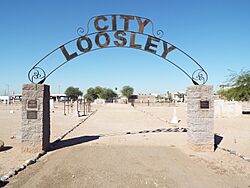
Entrance of the
City/Lossley Cemetery section
-
Entrance of the historic Pioneer Military and Memorial Park. It dates back to 1884. Listed in the NRHP.
-
The grave of John T. Alsap in the "Masons Cemetery" section. Alsap was Phoenix's first Mayor.
-
Grave site of Phillip "Lord" Darrell Duppa. He is credited with naming "Phoenix" and "Tempe."
-
Grave site of Jacob "Dutchman" Waltz. He was a German immigrant who found a secret gold mine.
-
-
-
Grave site of Czar J. Dyer. He served as City Councilman and acting Mayor.
-
Grave site of Noah M. Broadway. Broadway was one of Phoenix's original settlers.
St. Francis Catholic Cemetery
St. Francis Catholic Cemetery started in 1897. It's one of the oldest cemeteries in Phoenix. Many important people from Phoenix and Arizona history are buried here. Margaret Geare, buried in 1897, is believed to be the first person laid to rest here. The cemetery is located at 2033 N. 48th Street.
- St. Francis Catholic Cemetery
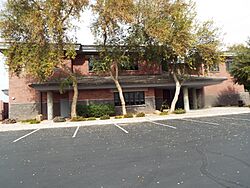
St. Francis Catholic Cemetery
-
Grave of Margaret Geare (1817–1897), the first person buried here.
-
Grave of Joseph Geare (1854–1911), who founded the Central Avenue Dairy.
-
Grave of Governor Rose P. Moffort (1922–2016). She was Arizona's first female Governor.
-
Grave of Trinidad Escalante Swilling Shumaker (1849–1925), known as the "Mother of Phoenix."
-
Crypt of Louis J. (Lou Ambers) D’Ambrosio (1913–1995). Ambers was a World lightweight boxing champion.
-
Grave of Ladimir Kwiatkowski (1928–1994), better known as Ladmo. He co-hosted a children's TV show.
Further information: St. Francis Catholic Cemetery
Greenwood/Memory Lawn Mortuary & Cemetery
Greenwood/Memory Lawn Mortuary & Cemetery is where many important people are buried. These include three Arizona Territory Governors, six Arizona State Governors, and the founder of Glendale, Arizona. Also buried here are the 1958 Indianapolis 500 winner and a famous journalist.
- Historic Greenwood/Memory Lawn Mortuary & Cemetery
-
Grave-site of Joseph H. Kibbey (1853–1924), the 16th Governor of Arizona Territory.
-
Grave-sight of Richard Elihu Sloan (1857–1933), the last Governor of Arizona Territory.
-
Crypt of Ernest William McFarland (1894–1984). He was a U.S. Senator and Arizona Governor.
-
Crypt of Paul Jones Fannin (1907–2002). He was a U.S. Senator and Arizona Governor.
-
-
-
Grave site of James Ernest Bryan (1926–1960). Bryan was a racecar driver who won the 1958 Indianapolis 500.
Further information: Greenwood/Memory Lawn Mortuary & Cemetery
Landmarks
This article includes pictures of the Deer Valley Rock Art Center and Papago Park. The Deer Valley Rock Art Center is a 47-acre archaeological site. It has over 1500 ancient rock carvings called petroglyphs. These carvings are between 500 and 7,000 years old! The site is listed on the National Register of Historic Places and as a Phoenix Points of Pride. A museum designed by Will Bruder was built there in 1994.
Papago Park is a desert park with hills. It covers 1200 acres in Phoenix. It's home to the Desert Botanical Garden, the Phoenix Zoo, and Hunt's Tomb. Hunt's Tomb is the pyramid-shaped burial place of Arizona's first governor, George W. P. Hunt.
Deer Valley Rock Art Center (Hedgpeth Hills Petroglyph Site)
- Historic Deer Valley Rock Art Center
(Hohokam Puebloans Petroglyphs and other items)
Listed in the National Register of Historic Places and
as a "Phoenix Points of Pride".
-
Entrance of the Deer Valley Rock Art Center Museum. It is listed in the NRHP and as a Phoenix Point of Pride.
-
National Register of Historic Places Marker.
-
A prehistoric Hohokam cooking pit.
-
-
This Petroglyph with a spiral was made by the Hohokams over 1000 years ago.
-
This Hohokam Petroglyph shows a "scene." You can see two deers bumping heads.
-
Notice the two deers bumping heads in this Petroglyph. This symbol represents the Deer Valley Rock Art Center.
-
View of the Hedgepath Hills and Sonoran Desert. The rocks were formed from lava.
-
Hohokam Petroglyph scene. These carvings are from 700 AD to 1050 AD.
-
-
-
Papago Park
The Desert Botanical Garden, Hole-in-the-Rock, and Hunt's Tomb are all in Papago Park. Papago Park was listed in the Phoenix Historic Property Register in 1989. The Desert Botanical Garden is a Phoenix Point of Pride. The Webster Auditorium inside the garden is listed on the National Register of Historic Places.
-
-
Different species of cacti on display.
-
The Webster Auditorium was built in 1939 inside the Desert Botanical Garden. It is named after Gertrude Webster. Listed in the NRHP.
-
-
Inside the historic Webster Auditorium.
-
The Hole-in-the-Rock is a Phoenix landmark. It's a series of openings in red sandstone.
-
View from inside the Hole-in-the-Rock.
-
Hunt's Tomb in Papago Park. This is the tomb of George W. P. Hunt, Arizona's first Governor. Listed in the NRHP.
Museums
A museum is a place where historical, artistic, or scientific items are shown and studied. Phoenix has many museums. The Heard Museum shows Native American culture. The Phoenix Art Museum displays art from different time periods.
This section includes the Pioneer Living History Museum and the Phoenix Trolley Museum. The Pioneer Living History Museum has 30 old buildings from the 1880s and early 1900s. The Phoenix Trolley Museum's main exhibit is a restored 1928 trolley car, #116.
You'll also see cars from the Martin Auto Museum and musical instruments from the Musical Instrument Museum. The Martin Auto Museum saves old cars for education. The Musical Instrument Museum has over 6,500 instruments from around the world. It even has John Lennon's piano and Elvis Presley's guitar!
Pioneer Living History Museum
- Original historic buildings and structures
-
The Ashurst Cabin was built in 1878. It was the boyhood home of Senator Henry Fountain Ashurst.
-
The Phoenix Bakery building was built in 1881. It was later moved to the Pioneer Living History Museum.
-
Phoenix Trolley Museum
- Phoenix Trolley Museum
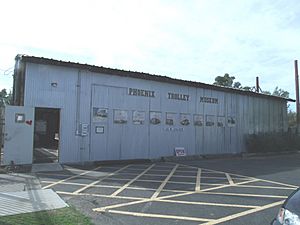
The Phoenix Trolley Museum, located at 25 W. Culver St. The main exhibit of the museum is trolley car #116, a restored 1928 trolley which served the original Phoenix trolley system.
-
Historic Trolley Car #116. It served Phoenix from 1928 to 1947.
-
Inside the historic Trolley Car #116.
-
Front inside view of Trolley Car #116.
-
Another view of Trolley Car #116.
Martin Auto Museum
-
1886 Benz Patent-Motorwagen.
-
-
-
- Musical Instrument Museum
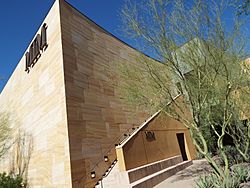
Musical Instrument Museum
-
-
-
-
Phoenix-Musical Intrument Museum-Cambodia exhibit.jpg
-
-
Laveen
Laveen is a community within Phoenix. Farmers and dairy workers first settled it in 1884. In the early 1900s, Walter E. Laveen and his family built the first general store there. Two properties in Laveen are listed on the National Register of Historic Places.
- Historic Laveen, Arizona
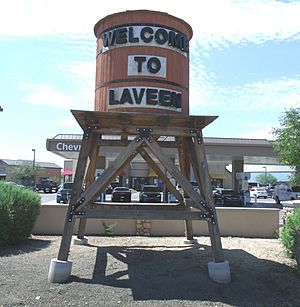
Laveen Village welcoming water tower
-
Another view of the Laveen Village welcoming water tower.
-
The Del Monte Market built in 1908. It is the oldest continuously operating market in Arizona. Listed in the PHPR.
-
Another view of Del Monte Market.
-
The Laveen School Auditorium was built in 1925. It is listed in the NRHP.
-
Another view of the Laveen School Auditorium.
-
The Laveen Post Office is where the original Laveen Village post office was established in 1918.
Sunnyslope District
The Sunnyslope community is a well-known neighborhood in Phoenix. It feels like a "small town" and its residents are proud of it. Sunnyslope tried to become its own town four times but didn't succeed. In 1959, Phoenix officially took over the Sunnyslope community. Sadly, most of its historic buildings have been torn down.
- Historic Sunnyslope District
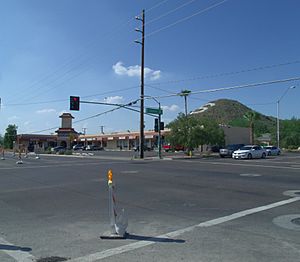
Intersection of Central Avenue and Hatcher Road in Sunnyslope
-
Sunnyslope Mountain, also known as "S" Mountain. Students painted the "S" in 1954. It is listed in the PHPR.
-
This is where the trail to the "S" on Sunnyslope Mountain begins.
-
A view from the trail on Sunnyslope Mountain.
-
This is where the historic Desert Mission of Sunnyslope was founded in 1927. It served the community until 1940.
-
This Marker shows where the historic Desert Mission of Sunnyslope was founded.
-
One of the low-rent cabins of Beatty's Court. These were for families with tuberculosis.
-
Beatty Court Cabins built in the 1930s and 40s.
-
The Sage Press Building was built in 1935. Sage was Sunnyslope's first newspaper.
-
The abandoned Sunnyslope Auto Upholstery Building was built in 1940.
-
This historic building once housed "Peoples Drug Store". It had Arizona's first pharmacy drive-through. It is now the Sunnyslope Historical Society and Museum.
-
A display of pharmacy equipment inside the Sunnyslope Historical Society and Museum.
-
Dorothy Gunderson poses in front of the John C. Lincoln display.
-
The Dr. Kenneth E. Hall house built in 1946.
-
The Sunnyslope Presbyterian Church was built in 1949.
-
The historic Mennonite Church Meetinghouse was built in 1946.
-
The First Mennonite Church of Sunnyslope was built in 1949.
-
The historic Lovinggood House was built in 1945. It is now owned by the Sunnyslope Historical Society.
-
Another view of the 1945 historic Lovinggood House.
-
Inside the living room of the Lovinggood House.
-
The kitchen of the Lovinggood House.
-
The bedroom of the Lovinggood House.
-
The Sunnyslope Rock Garden was created by artist Grover Cleveland Thompson.
-
A snake sculpture by Grover Cleveland Thompson.
-
The Sunnyslope Rock Garden was created from 1952 to 1972.
-
Thompson's art in the Sunnyslope Rock Garden.
-
The Charles and Eleanor Abel House was built in 1955. It was the first house in Sunnyslope with a bomb shelter.
-
Location of one of the bomb shelter windows.
-
Phoenix Fire Station #7 was built in 1966. It is considered historic.
-
An area of the fire station dedicated to the people of Sunnyslope.
-
The historic "El Cid Castle" was a bowling alley that looked like a Moorish Castle.
-
Another view of El Cid Castle. It is being restored.
-
Side view of El Cid Castle.
-
Another side view of El Cid Castle.
-
The John C. Lincoln Medical Center built in 1965.
Images for kids
-
Historic Washington Street
-
Location in Maricopa County and Arizona
See also
Historic structures in Phoenix with articles






